The Life, Letters and Work of Frederic Leighton by Mrs Russell Barrington Volume 2 Chapter V
The Life, Letters and Work of Frederic Leighton by Mrs Russell Barrington Volume 2 Chapter V is in The Life, Letters and Work of Frederic Leighton by Mrs Russell Barrington Volume 2.
Chapter V. Leighton As President Of The Royal Academy 1878-1896
Leighton was at Lerici in the autumn of 1878, visiting his dear old friend Giovanni Costa ("an artist in a hundred—a man in ten thousand," were Leighton's words describing him), when he received a telegram stating that Sir Francis Grant was dead. "The President is dead! Long live the President!" exclaimed Costa. Leighton remained in Italy, sketching landscapes and painting heads—one, the portrait of Costa—till his holiday was over, the end of October. On the 18th of November he was elected President of the Royal Academy. Thirty-five Academicians voted for Leighton, five for Mr. Horsley.
Leighton wrote to his younger sister:—
Dearest Gussy,—You perhaps have heard from Lina that I had an overwhelming majority, and that the outer world beyond artistic has warmly received my election, which is of course infinitely gratifying, but fills me with a dread of disappointing everybody. Monday I go to Windsor to be knighted. Yes, I got a first-class gold medal for my statue[58]—at least, it was awarded, and I shall get it some time. I also don't mind telling you in strict confidence—because it is not yet a fait accompli—that I am, I believe, to have the "ruban" of an Officier de la Légion d'Honneur. I am so glad, dear, your wrists are better—may they keep so. Love to old Joseph (Joseph Joachim) when you see him.
Note 58. "Athlete Strangling a Python," exhibited in the International Exhibition, Paris, 1878.
Most treasured of all congratulations were doubtless these lines from his beloved master, Steinle:—
Translation.
Frankfurt am Main, December 1, 1878.
Dear and honoured Friend,—To-day I have read in the paper that the choice of President of the Royal Academy has fallen upon you, and since I am convinced that this distinguished position is both appropriate to your services to art, and also certainly well merited, you must permit an old friend, who remains bound to you in love only, to offer you his dearest and warmest good wishes upon this honour. I pray God, that your position may provide you with great power in your country for good so as to enable you to encourage the noblest things in art. I am convinced that you, dear friend, will make a right and fruitful use of it. I often set my pupils to make enlarged drawings of single groups from your medieval Equipment for the Defence of the Town,[59] and rejoice in the admirable studies which you made for that cartoon. I, dear friend, am in my old age still active and industrious, and would gladly go on learning. Should God grant life, I shall next year complete my work on the Strassburg master, which will demand all my love and strength. Here we have now built a new gallery, on the other side of the river Main, and a new studio. The collections are good, and more suitably accommodated than heretofore, and there is no want of space for future additions. Perhaps one of your journeys will bring you again to the old Main town, and so to the arms of your old friend. My dear President, I repeat my good wishes, and remain with all my heart, your truly devoted,
Edw. Steinle.
Note 59. "The Arts of War."
From his birthplace Leighton received the following announcement:—
BOROUGH OF SCARBOROUGH.
At a meeting of the Council of the Borough of Scarborough, in the County of York, held in the Town Hall in the said Borough, on Monday the ninth day of December, 1878,—
Present,—The Mayor (W.C. Land, Esq.) in the chair,—
It was moved by the Mayor, seconded by Alderman Woodall, and resolved unanimously: "That this Council learns with peculiar satisfaction and pleasure of the election of a native of Scarborough, in the person of Sir Frederic Leighton, to the Presidency of the Royal Academy, and respectfully offers to Sir Frederic its warm congratulations, and records its conviction that his great talents as an artist, his attainments as a scholar, and his many striking qualifications, eminently fit him to adorn the high position to which he has been called."
W.C. Land, Mayor.
Robert Browning wrote:-
19 Warwick Crescent, W., November 14, 1878.
Dear Leighton,—I wish you joy with all my heart, and congratulate us all on your election. There ought to have been no sort of doubt as to the result, but the best of us are misconceived sometimes, though in your case never was a right more incontestable. All I hope is that your new duties will in no way interfere with the practice of your Art. I only venture to write, now, as one who, so many a year ago, saw your beginning with "Cimabue," and from that time to this remained confident what your career would be. But you know all this, and it requires no answer, being rather a spurt of satisfaction at my own original discernment than any assurance which I can fancy you need from,—Yours very truly,
Robert Browning.
Pen's letter to me, two days since, contained his earnest wishes for what has just happened, and he will be delighted accordingly.
From Matthew Arnold:—
Athenæum Club, Pall Mall, S.W.,
November 15.
My dear Leighton,—One line (which you need not answer) to say how delighted I am to see what an excellent choice the Royal Academy has made.
I only hope poor O'Conor may not take advantage of the occasion to plant an ode and a letter.—Ever sincerely yours,
Matthew Arnold.
From Hubert Herkomer:—
November 27, 1878.
My dear Sir Frederic Leighton,—I am just recovering from an attack of brain fever, and although I am not allowed yet to write, I can no longer wait without dictating a letter to express my own individual pleasure at your being the new President.
Three years ago you wrote me a letter after seeing my "Chelsea Pensioners." Perhaps you little dreamt of the tears of joy that that letter caused in a young painter, who will always feel that he owes you a debt of gratitude; and now he glories in your being the chief of that body which attracts to it all the principal art of the country. All England feels that you, from your new position, will give new life to it. Perhaps you will allow me, when I am sufficiently recovered, to come and see you.
In the meantime believe me to be, with most heartfelt congratulations,—Sincerely yours,
A.H., pro Hubert Herkomer.
A friend writes:—
November 15.
Dear Mr. Leighton,—I have tried to keep silence, telling myself that it cannot matter what I think or feel on the subject (and that it may seem to you a very unnecessary proceeding!); but I cannot resist the temptation to tell you how warmly I rejoice, and how earnestly I congratulate myself and all other hungerers after wholesome beauty of colour and form, and high ideals of greatness and purity, on your acceptance of a position that one may hope will, nay must, influence the Art of this time for good in every sense. One takes a great breath of relief as one thinks of it!
Were I to describe to you the effect your works produce on me, and the feeling of real reverence I have for them, I should appear to exaggerate, and should certainly bore you, so I will say no more! and I am not given to that sort of thing.
My beloved Lady Waterford was much disappointed that you could not come and meet her; I need not say, so were we: it was a great enjoyment to have her, she is like no one else; and I yet hope you may come and meet here some day. Pray do not answer this; of course you are overwhelmed with business, and it would hurt me to have it considered and acknowledged as a complimentary civility! whereas it is nothing but an involuntary overflowing to relieve my mind.
From Lord Coleridge:—
1 Sussex Square, W.,
November 24, 1878.
My dear Leighton,—Let me add one voice more, small but true, to the great chorus of applause with which your election has been greeted. It might seem left-handed praise to say that your election was the only possible one; but it is very true praise to say it was the only possible one if the highest interests of English Art, and of the Academy itself, were the sole object of the electors.
It would have pleased and touched you to hear old Boxall speak of it. I dined with him alone on Friday, and he was just and generous, as he always is, in his appreciation of you, and looked forward to your reign as likely to be one of high aims and noble motives. It is a small thing to say, but I venture to agree with him.—Ever sincerely yours,
Coleridge.
These are a few among many hundred congratulatory letters Leighton received on his election. One from Mrs. Fanny Kemble he answered in the following March, when already he was beset by requests to use his influence to get friends' friends' work hung on the walls of the Academy:—
March 20, 1879.
Dear Mrs. Kemble,—Many thanks for your very amiable words of congratulations on the honour done me by the Royal Academy. The kind sympathy shown towards me by my friends had added very greatly indeed to the pleasure my election gave me. The belief entertained by Miss —— that the admission of works to an exhibition is a simple matter of personal favour, is shared by all foreigners—and I fear by many English people—and places me at this time of year in much and often painful embarrassment. So robust is this belief, that those who, having applied to me, fail to find their works on our walls ascribe their absence to personal unfriendliness or discourtesy on my part, or, to say the least, to lukewarmness. As a matter of fact each work of art is admitted or rejected by a separate vote of the Council, and that in complete ignorance (except where authorship saute aux yeux) of the artist's name. This applies equally to English painters and foreign artists who reside here. In regard, however, to foreigners sending from abroad, whilst the vote is taken in the same way, admission is much more difficult. We have so many Anglo-foreign painters who live amongst us that, our Exhibition not being international, we can only admit a very limited number of really prize works. These works are therefore brought before us separately, and a small number of them selected, according to the space we have to deal with; I myself as a rule dissuade my foreign friends from sending except in cases where their merit is really very great; this may be Miss —— case; you will best know. I am quite sure, my dear Mrs. Kemble, that you do not doubt the pleasure it would give me to serve you in the person of your friend, and will not misinterpret these lengthy explanations.
And now I have a favour to ask of you. On Wednesday the 26th, at 3 o'clock in the afternoon, Joe will, I hope, play at my studio, and with him Miss Janotha and Piatti; Henschel will, I hope, sing. Will you give me the great pleasure of seeing you amongst my friends on that occasion?—Believe me always, yours very truly,
Fred Leighton.
On December 10, 1879, Leighton delivered his first address to the students of the Royal Academy—one of the finest of the many fine achievements of Leighton's life. "Purely practical and technical matters" he put aside to look into a wider and deeper question, that of the position of Art in its relation to the world at large in the present and in the past time, in order to gather something of its prospects in the future. If the question why Leighton held indisputably the great position he did were asked me by one who for a first time had heard his name, I should be inclined to answer, "Because he contained within him the combined powers to execute completely the art which he created, and to think out and feel such profound, sympathetic, and wise truths as those to be found in this address."[60]
Note 60. "Addresses delivered to the Students of the Royal Academy by the late Lord Leighton." Publishers: Kegan Paul, Trench, Trübner & Co. 1897.
Among the large number of appreciative letters Leighton received were the following.
Millais wrote:—
2 Palace Gate, Kensington, December 11, 1879.
Dear Leighton,—I was suffering all yesterday with tooth-ache, otherwise I would have attended the distribution last night. The ceremony is always most interesting to me, awakening as it does many anxious and happy recollections. My object in writing to you is to say I have read your address, which I think so beautiful, true, and useful that I cannot but obey an impulse of congratulating you upon it. For some time past I have been putting down notes on Art which some day may be put into form, and I find we are thinking precisely in the same way. I have used identical words in what I have written to those you delivered yesterday.
The exponents of Art surround it in such a cloud of mystery that it is a real gain when a practical authority is able to say something definite and clear the way.—Yours sincerely,
J.E. Millais.
His poet-friend wrote:—
Woodberrie, Loughton, Essex, December 11, 1883.
My dear Sir Frederic,—Have any of the multitude of men who love you ever called you Chrysostom? It seems so natural after reading yesterday's address. Will it be published by itself and obtainable in some handier form than the broadsheet of the Times? I want it as part of the education of my daughter, who now, at sixteen, is beginning to take a new interest in whatsoever things are lovely and of good report, and I want it for myself, for in its lovely suggestiveness and exquisite English I could often find refreshment when I wanted (and needed) to "travel in the realms of gold," and forget my own invalided personality under the magic of such guidance.
My wife desires me to say a word of gracious remembrance to you, and I am ever, faithfully yours,
Robin Allen.
Mr. Briton Rivière:
Flaxley, 82 Finchley Road, N.W., December 11, 1879.
Dear Sir Frederic,—After hearing your admirable address last night, I came home in despair, for what little basis of thought is contained in my lectures (more especially in the second one) is built chiefly upon two or three of the lines of argument that you have already expressed so beautifully: Sincerity in the student—The effect of his own time upon him—That time in its relation to the time of the Old Masters, and the temper of mind in which the Old Masters should be studied; on these points my lectures are but a feeble echo of what I heard last night.
My first thought was to change my whole line of battle, and re-write them, but the extreme limitation of my powers of work would make this too great a sacrifice. To throw them up altogether, which I should much like, is impossible, for I am pledged to the Academy to do my best.
Clearly, I must go on, but I shall do so more easily now that I have explained my position, so that if any one who hears me should tell you that my lectures were only a parody of what you had already said so well, you will believe that it has been the misfortune and not the fault of yours very truly,
Briton Rivière.
Don't trouble to answer this.
Matthew Arnold:—
Athenæum Club, Pall Mall, April 19, 1880.
My dear Leighton,—You have been better than your word, for I see you have made me the actual possessor of your "address." From the glance I have already taken at it, I see that I shall both like it and you with it; but of this I might have been sure beforehand. A thousand thanks, and believe me, always sincerely yours,
Matthew Arnold.
The scheme Leighton formed, when first considering the duty among all others he undertook,[61] of addressing the students at the biennial meetings, was begun and continued in the nine addresses he gave, but unfortunately it could not be completed, a fact he sorely regretted when discussing the question with me three months before his death. On December 10, 1879, "The position of Art in the World" was the subject. In 1881, "Relation of Art to Time, Place, and Racial Conditions; Underlying Mystery of its Growth and Decay." In 1885, "Summary of Foregoing Lecture." In 1887, "Art in Mediæval and Modern Italy." In 1889, "Relation of Artistic Production to Surrounding Conditions considered in reference to Spain." In 1891, "The Art of France: its uninterrupted development; its wide field; eminent achievement in Architecture; the Gothic style." In 1893, "The Art of Germany: its high qualities; deficient Æsthetic Inspiration." The tenth was to have consisted, Leighton told me, in a summing up of the nine former addresses, in order to prove how they had affected the past and present condition of Art in England. To any thoughtful artist these utterances, delivered by so great and accomplished an authority, cannot fail to prove profoundly interesting and invaluable as references, on account of the sound knowledge and the absolutely reliable quality of the facts given; but it may be doubted whether the more informative matter, contained in the six later lectures, suited Leighton's style of oratory so happily as did the more abstract quality of the three first. There appeared to be too many names crowded into the comparatively short time which Leighton allotted to himself for the delivery of these discourses, for the normal taking-in power of an audience; the very finished rhetoric, moreover, in which the enormous amount of information contained in each was disclosed, did not seem quite appropriate to their condensed form. In conversation I have heard Leighton far more convincing, on the same subjects as those he treated in the last six discourses. The same intense sense of the duty he felt to do the thing as completely as it was possible, which he evinced in painting, cropped up again in his oratory, no less than the intense modesty—which would not recognise how great he could be if he relaxed all effort, and was simply himself.
Note 61. "Not everybody," wrote the late Mr. Underhill, who for some time, as private secretary to Sir Frederic Leighton, had special opportunities of knowing, "is aware of the tax upon a man's time and energy that is involved in the acceptance of the office in question. The post is a peculiar one, and requires a combination of talents not frequently to be found, inasmuch as it demands an established standing as a painter, together with great urbanity and considerable social position. The inroads which the occupancy of the office makes upon an artist's time are very considerable. There is, on the average, at least one Council meeting for every three weeks throughout the whole year. There are, from time to time, general assemblies for the election of new members and for other purposes, over which the President is bound, of course, to preside. For ten days or a fortnight in every April he has to be in attendance with the Council daily at Burlington House, for the purpose of selecting the pictures which are to be hung in the Spring Exhibition. He has to preside over the banquet which yearly precedes the opening of the Academy, and he has to act as host at the annual conversazione. Finally, it is his duty every other year to deliver a long, elaborate, and carefully prepared 'Discourse' upon matters connected with art, to the students who are for that purpose assembled. It is a post of much honour and small profit." "To administer the affairs of the Academy, to fulfil a round of social semi-public and public engagements, and to paint pictures which invariably reach a high level of excellence, would, of course, be impossible—even to Sir Frederic Leighton—were it not for the fact that he makes the very most of the time at his disposal. 'That's the secret,' remarked a distinguished member of the Academy to the present writer some little time before the President's death; 'Sir Frederic knows exactly how long it will take to do a certain thing, and he apportions his time accordingly.'"—"Frederic, Lord Leighton, P.R.A.: His Life and Works." By Ernest Rhys.
Mr. Briton Rivière, in the notes he furnishes for this book, writes:—
"Those perhaps sometimes too perfectly built-up sentences, of which his admirable addresses and speeches were formed, were the outcome of this same quality of mind. One of his most intimate friends, when we were talking about the mental strain occasioned by these, once said to me: 'Leighton would never get over a slight lapse of grammar,' and I can believe it. The accidental was hateful to him when considered in reference to his own work of any kind, though probably no one knew better than he did its value in a work of art; but, as Watts deplored, he never would use it or admit it into his own pictures. This quality and its strain upon him was illustrated by an accident which occurred at his last R.A. Banquet speech, the last he ever made, and which gained immensely from the fact that in one place he forgot for a moment the next sentence, and came to a pause (as he told me afterwards), in fear that he had broken down altogether; but his suspense, painful as it must have been to him, looked perfectly natural and spontaneous, and gave to his speech that touch of something which his better remembered periods did not express so well. This system of speaking entirely from memory added much to the constant strain of his Academy work. He had what he called a 'topical memory,' viz. he remembered the place of each word in his written speech and used to read it off in the air with never-failing accuracy, but did so always with the belief that a forgotten sentence would shipwreck the whole. If he would have been content now and then to lapse from this high pitch of the accuracy he aimed at in all his work, few could have reached a safer or higher standard spontaneously, as he proved in the Royal Academy, General Assembly, and Council meetings, when he never failed to speak admirably on the spur of the moment; and his summing up of a debate there on any subject was invariably marked by the same elegance and cleverness as his prepared speeches, but with more vitality and flexibility, which, however, never led him into anything that was not almost fastidiously exact and precise. I have always felt that no one who had heard only his elaborately prepared speeches knew his real power as a speaker."
Throughout their pages are to be found most suggestive passages, inspiring new thoughts and, to any but experts, new facts on vitally interesting art matters. For instance, take the description of Velasquez:—
"For a long period Italian painting did not cease to enjoy the favour of the Court; it ceased, however, towards the beginning of the seventeenth century to exercise that paralysing influence which had marked its first advent, and the ground was cleared for a new impulse from within. At this conjuncture a man of commanding genius and fearless initiative was given to Spain in the person of Diego Velasquez. It may perhaps have surprised you that with such a name before my mind I should have spoken of Zurbaran, a man so vastly his inferior in the painter's gift, as perhaps the most representative of Spanish artists. I have done so because beyond any other artist he sums up in himself, as I have pointed out to you, all the complex elements of the Spanish genius. In Velasquez, Spanish as he is to the finger-tips, this comprehensiveness is not found. Of Velasquez all was Spanish, but Zurbaran was all Spain.
"Viewed simply as a painter, the great Sevillian was, as I have just said, vastly the superior of the Estremeño. He was in more intimate touch with Nature, and none, perhaps, have equalled the swift magic of his brush. On the other hand, depth of feeling, poetry, imagination were refused to him. The painter of the 'Lanzas,' the 'Hilanderas,' the 'Meninas'—works in their kind unapproached in Art by any other man—painted also, be it remembered, the 'Coronation of the Virgin' and the 'Mars' of the Madrid Gallery—types of prosaic treatment. In one work, indeed, Religion seems for a moment to have winged his pencil; but striking and pathetic as is his famous 'Crucifixion,' it does not equal in poignancy and imaginative grasp the presentment of the same subject by Zurbaran in Seville. But if we miss in Velasquez the higher gifts of the imagination, we find him also free from all those blemishes of extravagance which we have so often noted in this land of powerful impulses unrestrained by tact. Whatever gifts may have been refused to Velasquez, in his grave simplicity he is unsurpassed. If fancy seldom lifts him above the level of intimate daily things, neither does she obstruct for him with purple wings the white light of sober truth. In days in which the young Herrera could find favour; in a country in which Churriguera was possible, and euphuism was applauded, he never overstepped the modesty of Nature, nor forgot in Art the value of reticent control. I have not here to follow his career, nor the evolution of his unique and dazzling genius. Still less need I, before young artists of the present day, dwell on the wizardry and the luscious fascination of the brush of this most modern of the old masters. I will only, in conclusion, touch briefly on one or two points that are of interest, and one that is, perhaps, of warning.
"First, I would notice the purity and decorum of his art; a decorum not, I think, due to the characteristically Spanish laws under which the Inquisition visited with heavy penalties every semblance even of impurity in a work of art, but to a spirit dwelling in the people itself, of which those laws were but the somewhat exaggerated expression. It may be worth while also to note that yet another virtue of the Spaniards is, in one of his works, reflected in an unexpected manner, namely, their sobriety. It is a curious thing that in a certain class of Spanish literature a peculiar relish is shown for the portraying of moral squalor and the grovelling criminality of social outcasts. In Spanish Art, on the other hand, the picturesqueness alone of low life seems to have sought expression. You know what gentle Murillo made of his melon-eating beggar boys. Again, you saw not long ago upon these walls, in the 'Water-Carrier of Seville,' how at the outset of his career Velasquez turned his thoughts to subjects drawn from humble life, and you know how to the end he dwelt with peculiar gusto on the fantastic physiognomy of the privileged buffoons, dwarfs, and hombres de placer who haunted the Palace in his day. You know further that one of the most powerful works painted by him before reality of atmospheric effect had become his chief preoccupation, and when he sought exclusively after truth of character, a picture known as 'Los Borrachos,' represents a group of drunkards doing homage to Bacchus. It is a work of the most naked realism. Bacchus (Dionysos!), showing his repulsive vulgarity (what a blank to Velasquez was the poetic side of classic myths), is surrounded by a circle of kneeling rascals, rude and ragged enough, and supposed, no doubt, to be carousing; but here is the strange peculiarity of this work—in spite of all the accessories of a revel, and the flash of grinning teeth, we are unable to persuade ourselves that any one of the disreputable crew could ever be drunk. Imagine the subject treated by a Fleming.
"And now, though I am loth to touch one leaf of the laurels of so dazzling and so great an artist, I cannot pass in silence a circumstance which must be weighed in estimating Velasquez as a man, and which is not without bearing on his art. The virtues of his race, as we have seen, purified his work and gave it dignity; a Spanish foible, though it could not dim his genius, cramped, no doubt, and curtailed its production—namely, a tendency to subordinate everything to the pursuit of royal favour. I said a Spanish foible; for a superstitious rendering up of will and conscience to the sovereign, such as is, I believe, without example, had long been a growing characteristic of the Spaniard. On a memorable occasion Gonzalo de Cordoba himself, one of the noblest figures recorded in Spanish history—a man of a mind so fearless that he was bold to rebuke Pope Borgia himself face to face in the Vatican for the scandals of his life—did not scruple to break, in deference to what he considered this higher duty of obedience to his king, his solemn pledge and oath to the unfortunate young Duke of Calabria. So all but divine did majesty appear to the Spaniards, that divinity and majesty became almost as one in their eyes, and they spoke, in all solemnity, as 'Su Majestad,' not only of the Divine persons of the Trinity, but also of the sacrificial wafer. The prevalence of this feeling must plead to some extent in mitigation of the tenacity with which Velasquez canvassed—with success, alas!—to obtain at Court a post of an onerous and wholly prosaic character—the office of 'Aposentador Mayor,' a sort of purveyor and quartermaster, who, when his Majesty moved from one place to another, had to convey, to house, to feed, not the sovereign only, but all his suite. A post demanding all his attention, says Polomino, who goes on to deplore that this exalted office (which he has just told us any one could fill) should have deprived the world of so many samples of the painter's genius. We shall agree with our sententious friend, not, perhaps, in the satisfaction he derived from the honour conferred, as he imagines, on his calling, but in his sorrow over the loss we have sustained! And in the sight of canvases in which the execution of a sketch is carried out on the full scale of life we shall at once bow before the product of a splendid genius, and regret the signs of haste, the evidence of too scanty leisure, by which its expression has been marred. Truly it has been said, 'Art requires the whole man.'"
Note 62. While writing this discourse Leighton wrote to his father:—
Perugia, October 5, 1889.
Dear Dad,—You will be surprised to hear that your letter (for which best thanks) only came to my hands yesterday on my arrival here; it had apparently, after enjoying a junket through Spain, returned to England before its final despatch here. The envelope, which I enclose, will amuse you; Ulysses himself did not visit more cities of men! I am glad my Spanish tour is at an end; the insufferable heat, the long journeys, the frequent night travelling, have conspired to make it rather trying to me physically. I have never been thoroughly well the whole time. Here it is absolutely cold, and I shall probably soon begin firing; it rains also, and I fear the weather is altogether unpromising; but the air is magnificent, and I am very fond of the place, and I shall enjoy my stay as much as the necessity of writing my (adjective) Address will allow.
My journey through Spain, though fatiguing, was extremely interesting and very profitable to me for the matter in hand. My stay in Madrid was made more enjoyable by the extreme amiability of my very old friend our ambassador, who brought me into contact with two or three interesting people, from whom I gathered valuable information in regard to things Spanish; to say nothing of getting compartments reserved for me in trains, &c. &c. It is rather fortunate that our diplomatic representatives abroad are mostly personal friends of mine. Post is just going, so good-bye for the present.—Your affectionate son,
Fred.
Leighton mastered the Spanish language completely in the course of the few weeks he spent in Spain in 1866. A friend who was present gives an amusing account of an incident which occurred when Leighton dined with Mrs. Adelaide Sartoris after his return. He was sitting next Señor Garcia (only now just dead at the age of 102); the conversation was being carried on in Spanish. Mrs. Sartoris, in astonishment and admiration at the fluent manner in which Leighton was talking the language of which he did not know a word a few weeks before, exclaimed, "But, Señor Garcia, do say he makes some little mistakes!" "But he doesn't," replied Garcia; "he hasn't made one!"
Again, the seventh discourse is replete with inspiring suggestions about French architecture,[63] and in the last discourse the description of Albert Dürer is one which, in a few lines, gives a complete and vividly interesting setting to the great name.
"Albert Dürer may be regarded as par excellence the typical German artist—far more so than his great contemporary Holbein. He was a man of a strong and upright nature, bent on pure and high ideals; a man ever seeking, if I may use his own characteristic expression, to make known through his work the mysterious treasure that was laid up in his heart; he was a thinker, a theorist, and, as you know, a writer; like many of the great artists of the Renaissance, he was steeped also in the love of science. His work was in his own image; it was, like nearly all German art, primarily ethic in its complexion; like all German art it bore traces of foreign influence—drawn, in his case, first from Flanders and later from Italy. In his work, as in all German art, the national character asserted itself above every trammel of external influence. Superbly inexhaustible as a designer, as a draughtsman he was powerful, thorough, and minute to a marvel, but never without a certain almost caligraphic mannerism of hand, wanting in spontaneous simplicity—never broadly serene. In his colour he was rich and vivid, not always unerring as to his harmonies, not alluring in his execution—withal a giant."
Note 63. Mr. Norman Shaw wrote the following letter the day after he heard this address in 1891:—
6 Ellerdale Road, Hampstead, N.W., December 11, 1891.
Dear Sir Frederic,—I was so sorry I missed you last night. After the election I went into the galleries to find my people, and when I came out you had gone—and quite right too, for you must have been very tired.
I thank you very sincerely for your most admirable address. I had heard that it was to be on the subject of French Art, but I had not realised that it was to be entirely about Architecture! and as an architect I naturally feel very deeply its great and permanent value. It is altogether a new sensation to have a Presidential address devoted to the Mother of the Arts! and I am sure its influence will be wide, deep, and lasting.
Amongst the many regrettable phases of modern art, there is none that I feel more than the isolation that the three great branches of art exist under in this country (for in France I am sure it is quite different), and I cannot help feeling that your address is a tremendous step in the right direction; but, alas! I don't believe one in twenty of our colleagues understood what you were so clearly explaining, and I fear not one in fifty cared! But it is absurd to suppose that with the advancement of knowledge this state of things can last, so it is intensely satisfactory to have it on record that not merely have we had a President that knew all that is to be known about the art, but who also cared and loved it!
I thought your remarks on the French apse quite delightful. I have always felt this strongly, and though as an Englishman (Scotchman!) I like our square east ends, still I am bound to admit that there is a logical completeness about a chevet that the square end cannot claim. But I shall only weary you if I go on in this prosy way! so thanking you again most heartily for your grand contribution, believe me to remain,—Yours very sincerely,
R. Norman Shaw.
When the last addresses were given Leighton was getting very tired. The wheels were running down—vitality was waning. The great mental machine had begun to work more mechanically. We trace this in the manner in which he tackled his last discourse. While writing it at Perugia he wrote to his elder sister:—
Perugia, Thursday, October 12, 1893.
You have misconstrued my knee; I have no pain in it, at most occasionally a dull ache in the muscles and a slight soreness in the joint; but it is an incapacitating and depressing nuisance, and it won't move on. (I am writing near a window opening on to a clear, star-bright sky; far below, in the paese, I hear the tinkle of a wandering, nocturnal mandoline—how I like it!) You do me the honour to appreciate my having, during my recent precipitate odyssey, visited thirty towns in thirty days, noting things of which I had already accurate knowledge d'avance; but I can "go one better" than that: ten of the towns were absolutely new to me, and of the whole subject on which I am preaching, I knew as good as nothing when you last saw me. I suspect that, in spite of a lack of memory which baffles belief, I have a certain "uptaking" knack. My preachment will bore you, but you will (if you read it) detect an ensemble; but, for goodness' sake, zitti! They'll think, when they hear the P.R.A., that, Lor' bless him! he'd known it all his life. Nevertheless, enough for the day, &c. Best love to Gussy.—Affect. bro.,
Fred.
I remember—when my husband and I were sitting with him one afternoon after his return home that autumn—his saying, "I feel distinctly I have dropped one step down off of the ladder," and it was truly about that time that his doctor, Doctor Roberts, discerned the beginning of the disease which proved fatal. Already in 1888 he wrote:
"The reasons which have now for a good many years impelled me to decline any 'public utterances' outside Burlington House have increased in weight and force as life and strength wanes, and as demands on me grow in every direction. I am sometimes asked to speak in public, not only in London, but all over the country, and in all cases the demand is grounded on strong claims in so far as I am an 'official' artist. Assent once is assent always—assent in half the cases would mean the gravest injury to my work, and I am a workman first and an official afterwards. Things have their humorous side, for those who press me most are sometimes those who on other occasions most earnestly assure me that I 'do too much.' How tired I am of hearing it."
The speeches at the yearly banquets of the Royal Academy were extraordinary tours de force. Wherever Leighton took the lead—and he was seldom anywhere when he did not take the lead,[64]—he raised the tone of the proceedings, and convinced the outside world, no less than those taking a part in them, that the matter in hand was important and essentially worth doing. Personally I have always felt that the finished form of Leighton's diction tended rather to hide than to explain the real nature of the power which had this vitalising, elevating influence. This influence emanated, I believe, from the greatness of his "magnificent intellect" (to use Watts' words) being united with extraordinary will-force invariably employed in the service of the principles in which he had a profound faith. It was his persistent loyalty to these principles—backed by this abnormal will-force, giving it extra weight—which lifted Leighton's work in all directions on to so distinguished a level—and not—in the case of his speeches—his rounded periods, or his power over words, or his gift of facility in grasping a subject, though the Banquet speeches are also remarkable on account of the versatility he displayed in grasping many subjects from the point of view of the expert. Whether it was the Army, the Navy, Politics, Music—whatever, in fact, was the affair of the moment, he proposed the toast from what might be called the inside of the question, not merely treating his text as a matter of form.[65]
Note 65. From a boy, without any effort or thought on his part, he exercised an unquestioned domination over others. Speaking of the days when he, as a boy of seventeen, first made friends with Leighton in Rome, Sir E. Poynter said, "He knew he was clever, but he hadn't a particle of conceit. I never saw him cast down, he was always jolly and noble; none ever thought of refusing him obedience." Again, Sir E. Poynter refers to these early days in his Dedication to Leighton of "Ten Lectures on Art": "I came to-day from the 'Varnishing Day' at the Royal Academy Exhibition with a pleasant conviction that there is, on all sides, a more decided tendency towards a higher standard in Art, both as regards treatment of subject and execution, than I have before noticed; and I have no hesitation in attributing this sudden improvement, in the main, to the stimulus given us all by the election of our new President, and to the influence of the energy, thoroughness, and nobility of aim which he displays in everything he undertakes. I was probably the first, when we were both young, and in Rome together, to whom he had the opportunity of showing the disinterested kindness which he has invariably extended to beginners; and to him, as the friend and master who first directed my ambition, and whose precepts I never fail to recall when at work (as many another will recall them), I venture to dedicate this book with affection and respect." Signor Giovanni Costa wrote: "I remember once in Siena there was an unemployed half-hour in our programme. Leighton happening to go to the window of the hotel, exclaimed, 'The Cupola of the Duomo is on fire!' and as he said it he rushed downstairs to go there. I, being lame, could not keep pace with him, but followed, and on arriving in the Piazza attempted to enter the Duomo past a line of soldiers who were keeping the ground; but they would not allow me to. Seeing them carrying wooden hoardings into the cathedral, I shouted. 'You are taking fuel to the fire! Let me in—I am an artist and a custodian of artistic treasures.' The word 'custodian' moved them, and they let me pass. When I got inside the Duomo I found Leighton commanding in the midst. He was saying, 'You are bringing fuel to the fire.' There was a major of infantry with his company, who cried out, 'Open the windows!' Leighton exclaimed, 'My dear sir, you are fanning the flames; you must shut the windows.' He had placed himself at the head of everybody, and the windows were shut. From the cupola into the church fell melting flakes of fire ('cadean di fuoco dilatate falde'—Dante) from the burning and liquefied lead, which would certainly have ignited the boards with which they had intended to cover the graffitte by Beccafumi on the marble pavement. Our half-hour was over. Leighton looked at his watch and said, 'In any case the cupola is burnt; let us be off to the Opera del Duomo; Duccio Buoninsegna is waiting for us!'"
Note 65. Sir George Grove wrote after the banquet in 1882: "Dear Leighton,—Let me say a word of most hearty congratulations on the brilliant way in which you got through your Herculean task on Saturday. You are really a prodigy! Your last speech reads just as fresh and gay and unembarrassed as the first, and every one of the nine is as neat, as pointed, as perfectly à propos as if there were nothing else to be said! Thank you especially for the reference to the music business."
On asking Gladstone to the Banquet of 1880, Leighton received the following characteristic answer:—
My dear President,—I have received your letter with mixed feelings. You do me great honour, and I must obey you. But I long for the return of the good old times, lying within the long range of my memory, when the dinners of the Academy did not suffer the contamination of political toasts, and kept us all for three precious hours in purer air. Can you tell me when the practice was changed? I am not, I think, under the dominion of a pleasant delusion.—Yours most faithfully,
W.E. Gladstone.
In 1883 Leighton found it impossible to continue his duties as Lieutenant-Colonel of the 20th Middlesex (Artists) Volunteers, which post he had held since 1876, and he therefore resigned. He was then made Hon. Colonel and holder of the Volunteer Decoration.[66]
Note 66. The following is one of many letters of regret expressed when Leighton resigned:—
19 Queen Street, Mayfair, W., June 24.
Dear Sir Frederic,—I trust you will allow me to express to you the sincere regret I feel at your being compelled to give up your command of the "Artists." To myself volunteering has always been so inseparably connected with your command, that I cannot at present realise the extent of the blank which your resignation will create. I shall ever remember with pride that it was under your auspices that I rose through the ranks and obtained my commission.—Believe me, dear Sir Frederic, very truly yours,
W. Pasteur.
A few years later he made the following speech at a dinner given by his Corps, in response to a toast proposed to himself:—
We live in times so hustling and breathless, times in which so much happens in so short a space, that a few years seem to divide men and habits like a deep gulf, and I feel that in the eyes of many of you the toast that your C.O. has invited you in such friendly terms to drink is one possessing an almost antiquarian flavour interest; the more grateful therefore am I for the cordial response with which, not, I hope, solely in a spirit of discipline, but from a more human point of view, you have given to the call of Colonel Edis.
The sight of the old uniform recalls to me, in a vivid manner, a period when not only my years, but my circumferencial inches, were fewer, during which it was my pride, first in one grade, then successively in others, from the ranks to the command, to take my share in the doings of and the life of what I hope I may call, without egotism, one of the finest corps in the Volunteer service. I have now for some years laid by the coat, to be furbished up only for these annual gatherings, not without misgivings as to my power of getting into it; but I have not laid by, nor shall I lay by while I have life, my deep interest and my high respect for that great defensive force of which it is the sign, and which, having sprung into existence in a moment of emergency and national excitement, has shown through over more than a quarter of a century that it requires no excitement to sustain it, and is fed by no transitory fires.
But whilst I watch this great sign of national vitality with unchanging interest, there is of course an inmost corner of my heart in which that national movement appears to me clad in grey and silver, and the old corps still sits in the warmest place; praise of its performance is always to me the most grateful praise; strictures on its shortcomings, if like other human things it has any, will always find me sensitive, and the account which your excellent Colonel furnishes on these occasions of your year's growth, comes home to me more than other like utterances. Gentlemen, I have named your energetic and efficient commanding officer; there is this year a special reason why his name should be on my lips; he is about shortly to acquire by length of service the full colonelcy of which his long devotion to the cause makes him so worthy a recipient; and I should wish before sitting down to offer him an old comrade's hearty congratulation, and the expression of my confident hope that his advanced rank will only confirm him in his loyal and faithful efforts to promote the honour of the corps to which he, more fortunate than I, is still privileged to belong as an active member.
In 1894, on the occasion of fêting his friend Joseph Joachim and presenting the gift to the great master of a Stradivarius violin and bow from his friends, in recognition of the fiftieth anniversary of his first performance in London, Leighton made the following speech:—
Ladies And Gentlemen,—It was necessary that the motives and feelings which have drawn us together to-night should find brief expression on somebody's lips; and, in obedience to a command which has been laid on me by this Committee, I have to ask you to accept me, for a few moments, as your mouthpiece. Of the varied duties which life lays on us, there are some which we perform in simple discharge of conscience and with little joy; some, if few, into the discharge of which we can pour all our hearts; and such a duty is this which I have risen to perform.
I have said that I shall only ask your attention for a few moments, and you will feel with me the fitness of brevity; for besides that, in every case, taste imposes restraint in praise of those who are present before us, long drawn and redundant eulogy would clash strangely with that rare simplicity which is one of the qualities by which Joachim, the Man, compels the esteem of all whose fortune it is to know him. But there would be in it, I think, also a further deeper-lying incongruity, for we know that Joachim, the Artist, has risen to the heights he occupies, perhaps alone, by fixing his constant gaze on high ideals, and lifting and sustaining his mind in a region above the shifting fickle atmosphere of praise or blame. Well, it is now fifty years since he took his first step along the upward path, which he has trodden in wholeness of heart and singleness of purpose from earliest boyhood to mellow middle age. During these fifty years he has not only ripened to the full his splendid gifts as an interpreter, ever interpreting the noblest works in the noblest manner, leading his hearers to their better comprehension; not only marked his place in the front ranks of living composers by works instinct with fire and imagination; but shown us also, as a man, how much high gifts are enhanced by modesty, and how good a thing to see is the life of an Artist who has never paltered with the dignity of his Art.
Deep appreciation of these titles to respect and admiration has, as you know, led in Germany, the country of his adoption and his home, to an enthusiastic celebration of this, the fiftieth year of his artistic career; and we, his English friends, living in a country which we hope, nay, believe, is, after his own, not the least dear to him, have felt strongly impelled to express to him also in some form our gratitude, our sympathy, and our esteem. It has seemed to your Committee that these sentiments could not take a more fitting outward shape than that of the instrument over which he is lord: such an instrument, signed with the famous name of Stradivarius, and, as I am told, not unworthy of his fame, flanked with a bow the work of Tourte, and once the property of Kiesenwetter—such a fiddle and such a bow I now offer to him in your name. Its sensitive and well-seasoned shell will acknowledge and respond to the hand of the master, and the souls of many great musicians will, we hope, often speak through it to spellbound hearers. But we nourish another hope—the hope that, through the great waves of melody that shall roll forth from it under his compelling bow, a still small voice may now and again be interfused which, reaching his heart through his ears, shall speak to it of the many friends who, in spirit or in the body, are gathered round him affectionately to-night.
In 1888 Leighton delivered the superb Address at the Art Congress held at Liverpool on December 3 (see Appendix). No Life of this great man would be complete were his utterances on this occasion not given in full, for therein is found his creed on Art, and the records of those principles on which it was founded, expounded with clear force, fine analysis, and, above all, with supreme courage. The subject, moreover, as touching England's condition respecting Art, is one directly affecting English readers.
A matter of interest to the general Art world came under discussion at the Council meetings of the Academy in the winter of 1879 and 1880, namely, whether women were to be admitted as members of their body. A correspondence took place between Leighton and the late Mr. Henry Wells, R.A., on the subject. Leighton's personal inclination was certainly for admitting women into the body of the elect, as I know from conversations he had with me on the subject. He invariably sought to extend all art privileges to those who were, as artists, worthy to receive them. He told me, however, that the majority of votes against the inroad of women would be given as having regard to a question of convenience rather than to one of principle, namely, the difficulty the Academicians foresaw in admitting only one or two lady artist Academicians to the yearly Banquets, and the greater difficulty of extending invitations to lady guests.[67]
Note 67. The following correspondence took place between Leighton and Mr. Henry Wells, R.A.
To Sir Frederic Leighton, P.R.A.
January 27, (?) 1880.
I will avail myself of this opportunity to remark upon the statement you made in your summing up, viz. that if women were made members under the existing law they would not have the right to sit on Council.
If you can establish this, if you can show us that any one elected a "member" under our law can be debarred on the score of sex from taking a seat on the Council, then I will instantly allow that our laws do provide for the election of women, and that the very ground of our argument is proved to be a quicksand. When you endorsed the statement that came so naturally from Millais, Calderon, and Leslie, I felt the matter was serious, for I saw at once that you could not do justice to our argument in the summing up because its very foundation was misapprehended by you. Although the question is now disposed of, I beg of you to look closely into the matter and assure yourself of it. I only wish I had known beforehand where your doubts were centered, for I would have done my best to remove them. I know you will find, beyond all doubt and controversy, that any one made a "member" by election can make good a claim to a seat on the Council, just as Mr. Tresham made good his claim; and it is because our laws provide for only one kind of members—a Council-sitting kind—that we felt the necessity of providing for the election of a non-Council-sitting kind.
In making this distinction we follow the example of George the Third and the founders of the Academy (who presumably knew something of the understanding upon which the two ladies became connected with the Society), for their decision, when they administered the law in the Tresham case, excluded women from a privilege which could not be denied to a "member" elected under the law. Of course their and our interpretation is open to dispute; but this much is beyond dispute, that if the law is interpreted as providing for women being "members," then it also places them (against the intention, as we see, of the founders) upon the Council; and as the great majority of the present Academicians have made up their minds that women shall not sit on Council, legislation would be necessary on either reading of the law.
The schedule of privileges to be given on the one hypothesis, would on the other give place to a subtraction of privileges, and either schedule would be determined according to the varying shades of opinions of the members.
There would remain only this difference in the result; one schedule would be based upon a law that is open to varying interpretations, whereas according to our method the schedule was based upon a positive resolution providing for the election of women, thus removing the question from all future discussion and doubt.
H.T.W.
From Sir Frederic Leighton, P.R.A.
January 30, 1880.
"In regard to the women question, I perfectly saw your contention and the logical cohesion of your view, and I was familiar with the Tresham episode, only I dissent from your view; I maintain that there were from the first non-Council-sitting members—for 'members' the women certainly were. 'It is the King's pleasure that the following forty persons be the original members of the Society,' and they did not serve on Council, as the roster shows, though all members were supposed to have sat; of course the laws were for the original as well as the elected members, and if the privilege could be refused to an original member whose name stands on the paper that says that all members shall serve in Council, it can and must on the same grounds be refused to elected female members after the custom is consecrated by Royal sanction."
January 31, 1880.
"Dear Wells,—I should much like to hear what you wish to say about the office of Treasurer—there are several points connected directly or indirectly with the office which it will be well to consider before I ask the Queen to appoint, and I have called a Council for Thursday (the funeral is not till Tuesday), at which these matters may be considered. It would seem advisable and convenient that the Treasurer's work be done at the Academy, and not away from it. I think also that the wording of the clause appointing a Surveyor might be made clearer; it ought not to be possible for any one to misunderstand or misinterpret its bearing. Unfortunately I have an appointment to-morrow afternoon at 4.30, and my work in the day is so urgent, having to be handed over on a fixed day, that I cannot leave it—would Tuesday at five do? say at the Athenæum, or here a little later? we should still be forty-eight hours in advance of the Council. In regard to the women question, I perfectly saw your contention and the logical cohesion of your view, and I was familiar with the Tresham episode, only I dissent from your view; I maintain that there were from the first 'non-Council-sitting' members—for 'members' the women certainly were: 'It is Her Majesty's pleasure that the following forty persons be the original members of the Society,' and they did not serve on Council as the roster shows, though all members were supposed to have sat. Of course the laws were for the 'original' as well as for the 'elected' members, and if the privilege could be refused to an original member whose name stands on the paper, that says that all members shall serve on Council, it can and must on the same grounds be refused to 'elected' female members after the custom is consecrated by Royal sanction.—In haste, yours very truly,
Fred Leighton.
"I have said nothing in this letter about poor Barry, but you may imagine whether the tragic event has moved and haunts me."
To Sir Frederic Leighton, P.R.A.
February 1, 1880.
I am very glad indeed to have the statement of your views which you have given me on the women question. Everything is now clear, side matters are disposed of, and only a single point remains on which we have to join issue. On my part I hold that our laws are in a definite and unequivocal form. That their foundation is in the "Instrument" and that every addition to, or modification, or annulment of the provisions in that document has been made in the manner prescribed, viz. by "resolutions" passed by the General Assembly and afterwards sanctioned by the Sovereign. These acts of legislation are all drawn up in a special way (as to size and pattern), to receive the sign manual of the Sovereign; and the tablets arranged in the order of their dates constitute our Statute-Book. I hold that no law can be changed or privilege taken away except by a subsequent act of legislation done in the prescribed manner.
On your part you hold that laws can be changed and privileges taken away by a "custom consecrated by Royal sanction." Thus the issue raised is very clear and distinct indeed.
I will point out that the question as to women sitting on Council was only on one occasion, and then only incidentally, before the Academy. Until the Tresham case arose the ballot had been used in forming the Council, and consequently no question of rights could appear while that process remained unchallenged. But whether we are discussing a single act of adjudication, or such a succession of acts as may be called a "custom," is really immaterial, because the sole question before us is this—can any act or acts other than those of legislation override and supplant the enactments of our law?
If it could be established that our laws must give way to the class of acts you point to, it would then be the first duty of the Academy to have our records minutely searched to ascertain what other laws have been supplanted by administrative actions sanctioned by the Sovereign; and the historical method so much discountenanced at our last Assembly would in truth rise into paramount importance. Many cases would most probably be found. We have one in suspense before us at this moment—the case of the engravers.
The laws of the Academy distinctly provide (but not more distinctly than that without discrimination "members" shall sit on Council) that a vacancy in the case of R.A. engravers shall not be filled up until the assent of the General Assembly has been taken by vote. Since the making of that law only two vacancies have occurred. They were both filled up without a preliminary permission, and the Sovereign sanctioned the election. On your contention, therefore, the custom consecrated by these sanctions must override the law itself, and nothing at this time stands between Barlow and the Queen's signature to his Diploma.
The Constitutional question you have raised is certainly one of the highest importance, and I shall watch its development with great interest. It is a matter of little moment what the view of an ordinary member like myself may be, but not so with the President, and I offer no apology for endeavouring to throw light upon the subject.
H.T.W.
The following letters from Leighton to Mr. Wells give an insight into the kind of work which his office of President entailed, and of the characteristically thorough manner in which Leighton fulfilled them.
Thursday Evening, 1879 or 1880.
Dear Wells,—I have noticed during my last two sittings at your studio, that, whenever the deeply interesting subject of our Academy appeared on the tapis, it stood in the way of your work, and I have therefore purposely abstained, as you no doubt remarked, from going beyond the merest surface in the discussion of any of the points on which we have touched. I felt that the sittings I gave you being so few and so scantily measured out, the least I could do was not, wittingly, to make you lose your time. That is to say, I did not tell you to-day orally what I now write, namely, my impression on your proposed question concerning the Chantrey purchases. The characteristic straightforwardness and loyalty with which you wished me to be informed on the point beforehand will not permit me to be silent in regard to your view. I have looked with the greatest care into the extract from the will which we all have, and have given the matter that thought which is due to your earnest conscientiousness, and I have satisfied myself that the General Assembly is wholly without a locus standi in claiming to control the expenditure of the Chantrey trust moneys in any way whatever; those moneys never pass into its hands or come under its cognisance; they are paid into the hands of the president and treasurer, against their receipt, and are dealt with solely by the president and council for the time being. An attempt, therefore, on the part of the General Assembly to assume control in this matter is in my view out of order, and it would therefore be out of order to ask or answer a question based, as yours is, on that assumption. I think you will find this view in harmony with the opinion of the body; if it is largely challenged, I shall postpone the answer till I have taken a legal opinion, as the point is very important. Here are my cards on the table.—In haste, yours sincerely,
Fred Leighton.
Monday.
Dear Wells,—The usual stress of business has prevented me till now from thanking you for your note and valuable information; I shall, with great interest, turn to the passages you allude to as soon as I get a good opportunity, and what I read will have the greatest weight with me when I vote again on a purchase. It would not, however, touch my point in regard to the General Assembly, which can only interfere with a past purchase if it can be shown to be illegal; this can, of course, only be established by legal authority, and I am, myself, sorry that your first resolution does not run thus: That the President be requested to consult high legal authority as to whether such and such purchases are barred by the will of Sir F. Ch. If your misgivings on that head are shared by a majority the thing would pass immediately and undiscussed, almost.
As concerns your motion on the pension resolution, I own to much misgiving; I should not dream of alluding to this had you not yourself taken me aside about it the other day. I am so far at one with you in principle that I feel, I can't say how deeply, that it is our paramount duty to interpret in the largest and most elevated sense our duty to the art of the country that we may be worthy in the eyes of the enlightened portion of the community of our high place, and that it is equally incumbent on us to keep our personal interests vigilantly in sub-ordination. I think that one of the present resolutions militates against this last view, and I need not conceal from you that it has not my sympathy. I am, however, very strongly of opinion that the form of your opposition to it will not be supported, and that in your desire for a logical comprehensiveness, you will fail of your end, which by simple direct opposition to the particular measure on the principle you have already enunciated and explained, you might very probably, I believe, achieve. I need not, I think, assure you, my dear Wells, that nothing is further from my thoughts than any interference with a member's freedom; indeed, on that head my views are known to you; but I can't refrain from saying thus much to give you an opportunity of quietly thinking matters over (don't answer this) before Wednesday. After all, you want primarily to get rid of paragraph 6, not to ensure a dialectical triumph. If the alternative is between your Committee and the resolution as it stands, I feel absolutely convinced that you will be left in a very cold minority; but if you point out that paragraph 6 takes our bounties off the ground of necessity, our only tenable ground, in fact commutes a bounty into an unconditional claim (of a formidable pecuniary nature, too), you will march in, I can't help thinking, with flying colours.
Don't, I repeat, be at the trouble to answer this expression of the opinion of,—Yours sincerely,
Fred Leighton.
Monday, February 1, (?) 1881.
Dear Wells,—Since receiving your letter I have been so absolutely engrossed with business and work that I have not had time till now to answer it. I am sincerely glad you have asked for a little modification in the terms of the Lucy petition; meanwhile I have written to Gladstone, and my letter has been acknowledged with a promise to note its contents.
In regard to your Chantrey resolution, I feel that, after the manner of very busy men, I have written in haste and not made myself quite clear. I should like, first, to remove one apprehension which you seem to have entertained; however strongly I may be convinced of the correctness of my own view on the matter under discussion, I cannot too emphatically say that as long as the points at issue were still sub judice I should not countenance a purchase which should assume my view to be the right one; but no such postponement as would lead to this dilemma is to be feared; what I propose is this: as soon as ever we have closed the discussion on the schools, and whilst they are being printed in their amended form for final consideration, therefore, on Friday next, if we get through on Wednesday, or failing that on the 22nd or 23rd of February, the resolutions of Council will be put on the table in their rotation; as, however, the next step in the Chantrey affair is to merely hear my answer to your memorandum, and as I understand that discussion on it will not be expected till members shall have had it to consider at their leisure, I will read it and lay it on the table before I take up the resolutions of Council which stand on the paper before it, so that when it comes up for final discussion, presumably in the first days of March, it can be discussed and voted on with full mastery of the subject. It is on the agenda paper of THAT meeting that your affirmative motion will stand; it does not come into force till then, since it is contingent on the effect produced on your mind by my answer of Friday (or of the next meeting after).
With respect to Redgrave's motion, it may lead to a technical "censure" of the Council; but there are censures and censures, and nobody will suppose, certainly I never dreamt, that you meant to imply moral obliquity to us in regard to what we have done. I have not a word to object to what you advance about the right of complaint, but it does not exactly cover the case: if you caught us, say, taking our friends to the Exhibition (or ourselves) on Sunday, a matter on which no two opinions are admissible, then "a complaint" would be in its place; but in the matter of payment to Treasurer, two opinions may and do exist, and they can only be measured against one another by a vote, and a vote can only be taken on a motion.
Lastly, as to the new codification committee, I think with you, in strictest confidence, that —— was not a good choice; but he was chosen in the usual manner by a majority of votes: that your labours were not remunerated in the usual manner is an oversight, which, of course, must and shall be set right. There seems altogether, and your letter corroborates that impression, to have been much vagueness about the doings of the Committee as a Committee, though, as usual, much zealous work on your part. I do not gather that attendances were entered in a book, which is the machinery by which payment is generally regulated, and the Committee having lapsed without reporting to the Council on its labours (being a sub-committee of the Council of 1878, it lapsed by a natural death with that Council), the whole thing had fallen out of notice. I hope that the old sub-committee will put in their claims, which will very certainly be satisfied. The codification has frequently been in my mind, for I consider it of very great importance, but as it is my impression that I am considered to drive the work of the Academy full hard as it is, I have hesitated to impose more labours on my colleagues, even though I am always ready to share them.—Sincerely yours,
Fred Leighton.
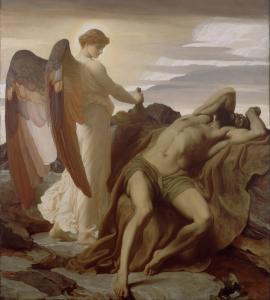 1879. Frederick Leighton (age 48). "Elijah in the Wilnerness".
1879. Frederick Leighton (age 48). "Elijah in the Wilnerness".
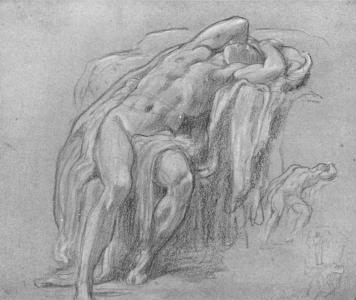 1879. Frederick Leighton (age 48). Sketch for "Elijah in the Wilnerness".
1879. Frederick Leighton (age 48). Sketch for "Elijah in the Wilnerness".
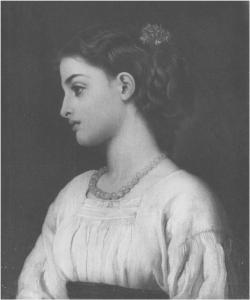 1879. Frederick Leighton (age 48). "Neruccia".
1879. Frederick Leighton (age 48). "Neruccia".
 Around 1890. Frederick Leighton (age 59). "The Bath of Psyche". Model Ada Alice "Dorothy Dene" Pullen (age 31).
Around 1890. Frederick Leighton (age 59). "The Bath of Psyche". Model Ada Alice "Dorothy Dene" Pullen (age 31).
Psyche: Psyche is the Greek goddess of the soul. She was born a mortal woman, with beauty that rivaled Aphrodite.
Tuesday Morning, 2 Holland Park Road, Kensington, W., March 18, 1884.
Dear Wells,—Thank you for your letter received yesterday, which only lack of time prevented me from answering at once. I am happy to say that Richmond cheerfully acceded to my wish in regard to clauses 6 and 7. I do not think with Calderon, who has written to me, that the words of a man so high-minded as Richmond will indispose members in this matter, and, though I feel the importance of raising no prejudice against the proposal as keenly as ever, still wish him to initiate it. It is, I agree with you, a pity that the question of the retiring pensions must come off first; but that is, I fear, quite unavoidable, and it connects itself with the very first resolution. I assure you, my dear Wells, that I see the bearing of all you say on this head as plainly as possible, and have done so all along; but it does not prevail with me, because it does not cover the whole ground, and because I do not anticipate the dangers for which you think it might be used as a precedent.
In view of my own personal painful position in this matter, I shall ask the Assembly not to ratify the clause which affects me.—In great haste, yours sincerely,
Fred Leighton.
Leighton's official life, as understood and carried out by him, entailed infinitely more strain and occupation than can be described in these pages, but, notwithstanding, unless the call away from his easel was imperative, he kept certain hours in the day sacred to his art. These were from 9 A.M. till noon, and from 1 P.M. till 4. It was only in the off hours that he got through his other labours, which he performed, nevertheless, with most assiduous conscientiousness.
Among his duties outside the Academy were those at the British Museum. Mr. H.A. Grueber, Keeper of the Coins and Medals, writes: "Sir Frederic Leighton was elected a Trustee of the British Museum on May 14, 1881. He was an active member of the Standing Committee, who practically manage the affairs of the Museum, and he took great interest in the place. He was also a member of the Sub-committees on Buildings, on Antiquities, Prints and Drawings, also of those on Coins and Medals."
In the first R.A. Exhibition after his election, three pictures of the eight Leighton sent have, I think, a special interest—"Elijah in the Wilderness" (the picture into which he said he put more of himself than into any other he had painted up to that time); the portrait of his very dear friend Professor Costa, painted in the previous autumn at Lerici, and the head "Neruccia." Leighton with Costa studied the methods used in painting by the Venetians and Correggio, and Costa wrote the following with reference to them:—
The result of these studies and of the experience of years was that Leighton and I definitely adopted the following method. Take a canvas or panel with the whitest possible preparation and non-absorbent—the drawing of the subject to be done with precision and indelible. On this seek to model in monochrome so strongly that it will bear the local colours painted with exaggeration, and then the grey, which is to be the ground of all the future half-tones; on this paint the lights, for which use only white, red, and black, avoiding yellow, and, stabbing (botteggiando) with the brush while the colour is wet, make the half-tints tell out from the grey beneath, which should be thoroughly dry. When all is dry, finish the picture with scumbles (spegazzi), adding yellow to complete the colour.
Leighton formed his method of painting from these general maxims, and he painted my portrait at Lerici on these principles as an experiment, and then in 1878 we adopted the system definitely. For this portrait he had four sittings—one for the drawing and the monochrome chiaroscuro, one for the local colours; then, having covered all with grey, he painted the lights with red, white, and black, making use of the thoroughly dried grey beneath for his half-tints. With scumbles he completed the colour and the modelling.
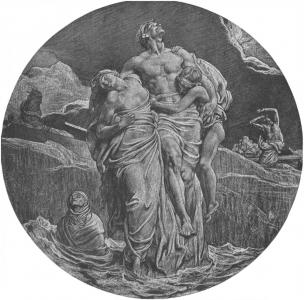 1892. Frederick Leighton (age 61). "And The Sea Gave Up The Dead Which Were In It". Sketch for Complete Design.
1892. Frederick Leighton (age 61). "And The Sea Gave Up The Dead Which Were In It". Sketch for Complete Design.
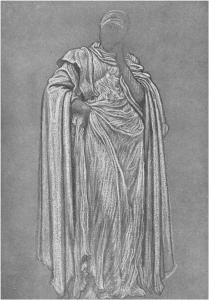 1886. Frederick Leighton (age 55). Study For Figure In Frieze, "Music." Leighton House Collection
1886. Frederick Leighton (age 55). Study For Figure In Frieze, "Music." Leighton House Collection
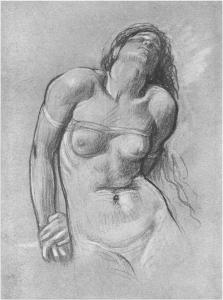 1890. Frederick Leighton (age 59). Study For "Andromeda." Leighton House Collection.
1890. Frederick Leighton (age 59). Study For "Andromeda." Leighton House Collection.
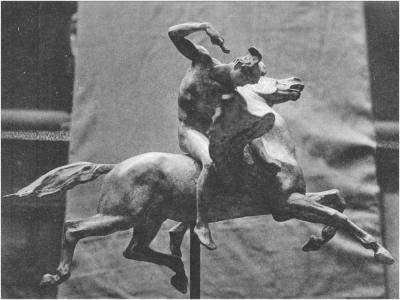 1891. Frederick Leighton (age 60). From Sketch In Clay For Perseus, In The Picture "Perseus And Andromeda."
1891. Frederick Leighton (age 60). From Sketch In Clay For Perseus, In The Picture "Perseus And Andromeda."
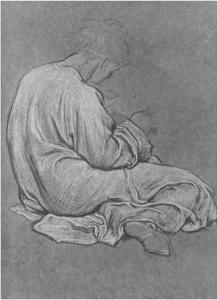 Frederick Leighton. Study For Figure In Panel In Royal Exchange—"Phœnicians Bartering With Britons". Leighton House Collection.
Frederick Leighton. Study For Figure In Panel In Royal Exchange—"Phœnicians Bartering With Britons". Leighton House Collection.
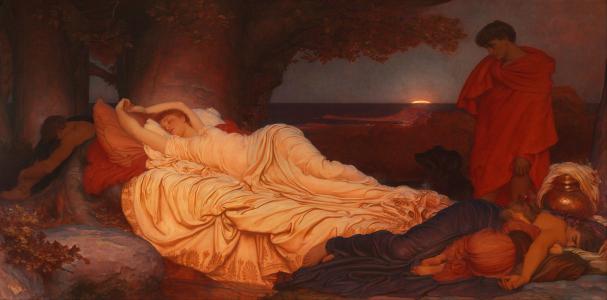 1884. Frederick Leighton (age 53). "Cymon and Iphigenia". Models sisters Ada Alice "Dorothy Dene" Pullen (age 25) and Isabella Helena "Lena" Pullen (age 11).
1884. Frederick Leighton (age 53). "Cymon and Iphigenia". Models sisters Ada Alice "Dorothy Dene" Pullen (age 25) and Isabella Helena "Lena" Pullen (age 11).
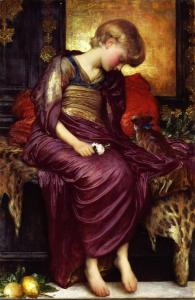 1884. Frederick Leighton (age 53). "Kittens". Model Isabella Helena "Lena" Pullen (age 11).
1884. Frederick Leighton (age 53). "Kittens". Model Isabella Helena "Lena" Pullen (age 11).
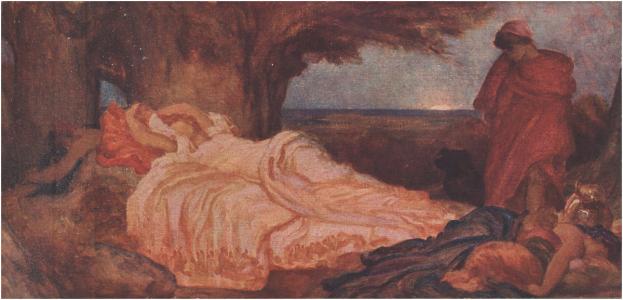 1884. Frederick Leighton (age 53). Study In Colour For "Cymon And Iphigenia."
1884. Frederick Leighton (age 53). Study In Colour For "Cymon And Iphigenia."
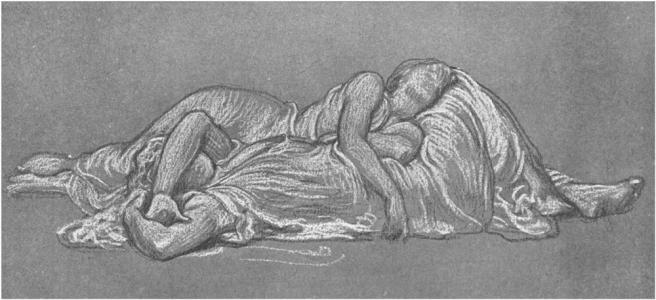 1883. Frederick Leighton (age 52). Study For Sleeping Group For "Cymon And Iphigenia". Given by Lord Leighton to G.F. Watts, O.M., and given by the latter to the Collection in Leighton House
1883. Frederick Leighton (age 52). Study For Sleeping Group For "Cymon And Iphigenia". Given by Lord Leighton to G.F. Watts, O.M., and given by the latter to the Collection in Leighton House
As the exquisite fragments in pencil of cyclamen, bramble and vine branch,[68] explain most intimately Leighton's genius as a draughtsman, so this head of Neruccia appears to me, together with one other work, to explain most explicitly his genius as a painter—a modeller with the brush. In 1890 Leighton painted "The Bath of Psyche."[69] The modelling in the torso of this figure, and in the head of Neruccia, reach the zenith as exemplifying Leighton's individuality as a painter. They might truly earn for him the title—Praxiteles of the brush.
Note 68. See Chapter III.
Note 69. Now in the Tate Gallery, purchased under the terms of the Chantrey Bequest.
It would be tedious for writer and reader alike to describe too minutely the special characteristics of even the most notable pictures painted during the seventeen years when Leighton occupied the position of President of the Royal Academy. Words are but poor interpreters of painting such as his. Eighty canvases, two statues, and two designs—the reverse of the Jubilee Medallion, "And the sea gave up its dead which were in it"—were exhibited at the Royal Academy; eighteen slighter works at the Suffolk Street, and twenty-three at the Grosvenor Galleries. On referring to the list in the Appendix it will be realised how great was the amount of labour involved in the achievement of many of these works, considering their size, the complication of their designs, and also the completeness of their finish. It must also be remembered that Leighton made many hundreds of studies for his pictures. More especially numerous were these for the designs "And the sea gave up the dead which were in it," "The Dance, Decorative Frieze"; "Cymon and Iphigenia"; "Music, a Frieze"; "Design for the reverse of the Jubilee Medallion," "Captive Andromache," "Perseus and Andromeda," "Return of Persephone," "The Garden of the Hesperides," "Rizpah," "Summer Slumbers," "The Spirit of the Summit," "Flaming June," "Phœnicians Bartering with Britons," and "Clytie." When all these achievements are taken into account it will be realised that Leighton, to the end, however important his duties outside his studios, was true to his vocation, and proved himself the "workman first and the official after."
As a work combining poetic feeling, power of design, and great beauty in the arrangement of line, while at the same time expressing most explicitly Leighton's creed of creeds—namely, the ennobling and elevating influence of beauty in the lives of men and women—"Cymon and Iphigenia" is perhaps the picture he himself would have chosen as the most representative among these later works. He chose it as the one he wished sent to the Berlin Exhibition in 1885. When beginning it he described to me the moment of the day he wished to catch for the scene—"the most mysteriously beautiful in the whole twenty-four hours, when the merest lip of the moon has risen from behind the sea horizon, and the air is haunted still with the flush of the after-glow from the sun already hidden in the west."[70]
Note 70. The owners of Leighton's pictures must feel satisfaction, not only in the fact that in all cases the beauty of the forms and arrangements of line grow on the eye more and more the longer they are studied, but also that the work itself improves by keeping. I noticed this to be the case very decidedly in "Cymon and Iphigenia." I had seen it when completed, the day before it left the studio in 1884; and when it returned there in 1901 (the owner, Sir Cuthbert Quilter, having kindly lent it for exhibition), and was placed in precisely the same light, I was surprised to see how much it had improved in tone during those seventeen years; it had gained so very greatly in those qualities which suggest the feeling Leighton wished it to inspire.
The study for the group of sleeping figures reproduced here is almost identical in design with the sketch in plaster from the clay, so lamentably destroyed when Watts lent it to be cast in bronze after Leighton's death. Leighton also gave the drawing of this group to his fellow artist, so enthusiastically did Watts admire it. He, in his turn, gave it to the Leighton House Collection in the year 1897, together with the fine painting which Leighton exchanged for his own portrait, painted about 1863, and which greeted friends as they mounted the staircase in Leighton House during all the years he lived in Holland Park Road (see frontispiece to Vol. I.). The study for "Cymon and Iphigenia" is particularly valuable now as an example of Leighton's rapid sketches where every touch reflects a mine of knowledge, because it was put under glass before any of the crispness of the touch was blurred by rubbing.[71]
Note 71. Leighton kept these precious studies he made for his pictures in a drawer where I was often invited, rather apologetically, to turn them over as if they were absolutely of no importance. I protested against the cursory treatment they received at the hand of their creator; and on seeing one superlatively beautiful study of drapery pinned on his easel one day, I implored him to have it glazed and framed before it ran any danger of being rubbed. He did so, and always alluded to it after as "that sketch you lost for me," because, being framed, he lent it to some one—he did not remember to whom—and it never came back. Periodically I asked if it had returned; "No—some one, I suppose, has taken a fancy to it," Leighton would reply. The pace at which he had to live in order to fulfil the work he had set himself, enforced great carelessness about his own interests in such matters. Unfortunately, after Leighton's death, the sketches were exposed to much defacement, a natural consequence of their being moved before being secured under glass.
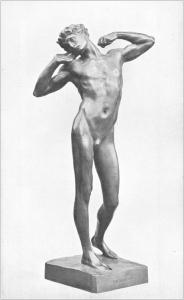 1886. "The Sluggard" From the Bronze Statuette—a direct reproduction from Lord Leighton's small sketch, 1886. Leighton House Collection.
1886. "The Sluggard" From the Bronze Statuette—a direct reproduction from Lord Leighton's small sketch, 1886. Leighton House Collection.
 1887. Frederick Leighton (age 56). "The Last Watch Of Hero."
1887. Frederick Leighton (age 56). "The Last Watch Of Hero."
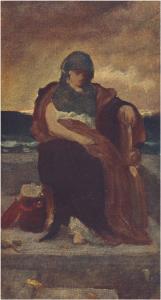 1890. Frederick Leighton (age 59). Study In Colour For "Tragic Poetess."
1890. Frederick Leighton (age 59). Study In Colour For "Tragic Poetess."
In a letter dated 1886 Watts wrote: "Leighton will carry off all the honours this year with his ceiling[72] and his two statues."
Note 72. Ceiling for a music room, painted for Mr. Marquand, New York.
"An Athlete Awakening from Sleep" (given to the Tate Gallery by Sir Henry Tate) is generally known as "The Sluggard," a name bestowed on it by Leighton himself. The victor's garland lies at the feet of the athlete, a garland which does not preserve the owner from a sad weariness. Mr. Brock, R.A., in whose studio "An Athlete" was modelled, executed the fine bust of Leighton which was deposited in the Academy as Mr. Brock's diploma work.[73] [The Sluggard]
Note 73. Mr. Brock gave a replica of this bust to the Leighton House Collection in 1897. It is from some points of view the most characteristic portrait of Leighton in existence.
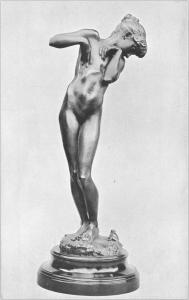 Sir John Millais admired greatly the other work alluded to in Watts' letter, "Needless Alarms." Leighton gave him this statuette, and Millais, desiring to show his gratitude in a tangible form, painted the picture "Shelling Peas" for Leighton.
Sir John Millais admired greatly the other work alluded to in Watts' letter, "Needless Alarms." Leighton gave him this statuette, and Millais, desiring to show his gratitude in a tangible form, painted the picture "Shelling Peas" for Leighton.
In at least fourteen of the eighty pictures shown at the Academy during the last seventeen years of Leighton's life, there can be traced an earnest sentiment beyond the "sincerity of emotion" for beauty which all evince. This feeling is, however, always guarded by a marked reticence from sentimentalism. "Elijah in the Wilderness," "Elisha Raising the Son of the Shunammite," "The Jealousy of Simœtha, the Sorceress," "The Last Watch of Hero," "Captive Andromache," "Return of Persephone," "Rizpah," "Tragic Poetess," "Sibyl," "Farewell," "The Spirit of the Summit," "Fatidica," "Lachrymæ," and the last passionate figure of "Clytie." The most popular pictures Leighton painted during these years appear to be "Sister's Kiss," "The Light of the Harem" (developed into a picture from the design of a group in the fresco, "The Industrial Arts of Peace"), "Idyll," "Whispers," "Wedded" (now in Australia), "Memories," "Letty," "Invocation," "Solitude," "The Bath of Psyche," "Bacchante," "Corinna of Tanagra," "The Bracelet," "Summer Slumber," "Atalanta," "Flaming June," and "The Fair Persian" (unfinished). Two sketches in the Leighton House Collection record effects which greatly fascinated Leighton in Scotland—"A Pool, Findhorn River," deep tortoiseshell brown; and "Rocks in the Findhorn," pink and grey enriched by lichen, and it was in Scotland that the Lynn of Dee inspired the subject of "Solitude." Leighton described to me the deep impression this Lynn of Dee had made on him. "It is the veriest note of solitude! a wonderful spot, full of poetic inspiration." In order to transmit a vivid record of this sentiment to his canvas, he took a second journey to the place.[74]
Note 74. Miss Emily Hickey, the poetess, was inspired by Leighton's picture to write the following lines:—
SOLITUDE
O'er the grey rocks, like monarchs robed and crowned,
High tower the firs in swart magnificence,
Where, winter after winter, vehemence
Of the wild torrent's rush, unstayed, unbound,
Hath scooped and worn the rocks till so profound
The deep pool's depth that all the gazer's sense
Fills with the absolute, dark-brown night intense.
The rapid current swirls, but never a sound.
By the high grandeur of the silence wooed
Into its bond of comradeship, the maid
Sits with the quiet on her bosom laid;
Not on the great unknowable to brood;
Only to wait a while till, unafraid,
She see the spirit of the solitude.
E.H. Hickey. Oct. 26, '91.
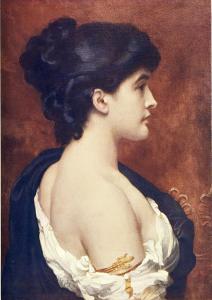 1893. Frederick Leighton (age 62). "Atalanta."
1893. Frederick Leighton (age 62). "Atalanta."
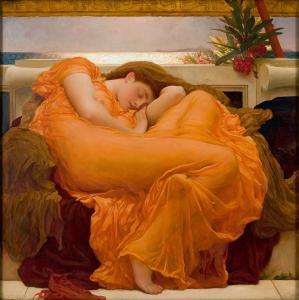 1895. Frederick Leighton (age 64). "Flaming June". Model Ada Alice "Dorothy Dene" Pullen (age 36).
1895. Frederick Leighton (age 64). "Flaming June". Model Ada Alice "Dorothy Dene" Pullen (age 36).
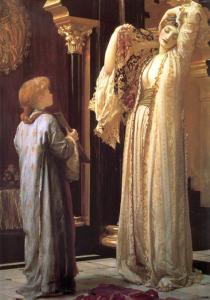 1880. Frederick Leighton (age 49). "The Light of the Harem". Model Isabella Helena "Lena" Pullen (age 7).
1880. Frederick Leighton (age 49). "The Light of the Harem". Model Isabella Helena "Lena" Pullen (age 7).
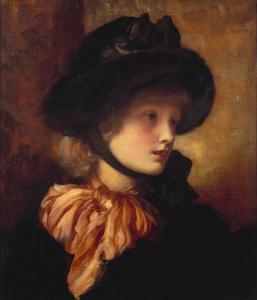 1880. Frederick Leighton (age 49). "Letty". Model Isabella Helena "Lena" Pullen (age 7).
1880. Frederick Leighton (age 49). "Letty". Model Isabella Helena "Lena" Pullen (age 7).
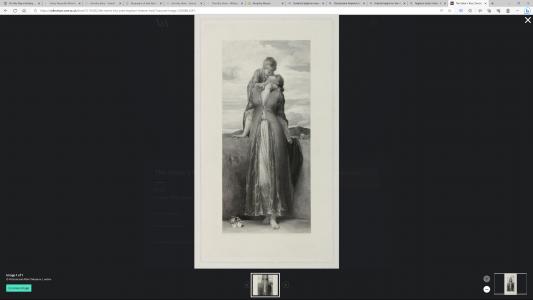 1880. Frederick Leighton (age 49). "Sister's Kiss". Model Isabella Helena "Lena" Pullen (age 7).
1880. Frederick Leighton (age 49). "Sister's Kiss". Model Isabella Helena "Lena" Pullen (age 7).
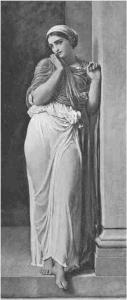 Around 1895. Frederick Leighton (age 64). "Cleobouline". Model Isabella Helena "Lena" Pullen (age 22).
Around 1895. Frederick Leighton (age 64). "Cleobouline". Model Isabella Helena "Lena" Pullen (age 22).
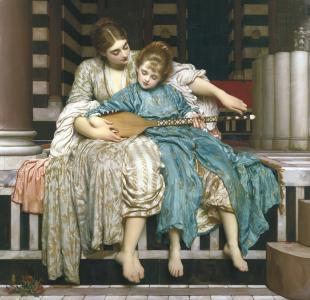 1877. Frederick Leighton (age 46). "The Music Lesson". Model Isabella Helena "Lena" Pullen (age 4).
1877. Frederick Leighton (age 46). "The Music Lesson". Model Isabella Helena "Lena" Pullen (age 4).
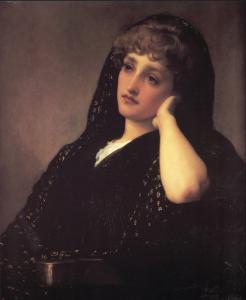 1895. Frederick Leighton (age 64). "Memories". Model Edith Ellen Pullen (age 29).
1895. Frederick Leighton (age 64). "Memories". Model Edith Ellen Pullen (age 29).
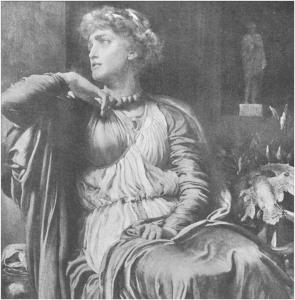 1895. Frederick Leighton (age 64). "The Jealousy of Simœtha, the Sorceress". Model Henrietta Sarah Pullen (age 27).
1895. Frederick Leighton (age 64). "The Jealousy of Simœtha, the Sorceress". Model Henrietta Sarah Pullen (age 27).
Henrietta Sarah Pullen: In Oct 1867 she was born to Abraham Pullen and Sarah Eagle.
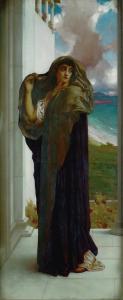 Before 1896. Frederick Leighton (age 65). "Farewell". Model Henrietta Sarah Pullen (age 28).
Before 1896. Frederick Leighton (age 65). "Farewell". Model Henrietta Sarah Pullen (age 28).
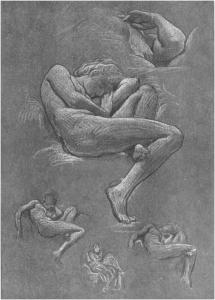 1895. Frederick Leighton (age 64). Study for "Flaming June". Model Ada Alice "Dorothy Dene" Pullen (age 36).
1895. Frederick Leighton (age 64). Study for "Flaming June". Model Ada Alice "Dorothy Dene" Pullen (age 36).
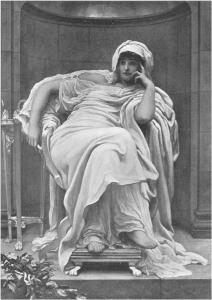 1894. Frederick Leighton (age 63). "Fatidica".
1894. Frederick Leighton (age 63). "Fatidica".
 1894. Frederick Leighton (age 63). "Fatidica".
1894. Frederick Leighton (age 63). "Fatidica".
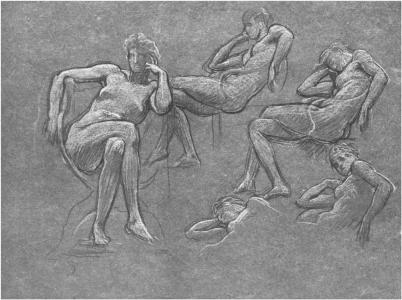 1894. Frederick Leighton (age 63). Studies for "Fatidica".
1894. Frederick Leighton (age 63). Studies for "Fatidica".
Leighton wrote the following letter to his father when first visiting Forres, in which he described the "craze" he had for these "dark brown Scotch rivers":—
Royal Station Hotel, Forres, N.B.
I drove over to Dunkeld (twelve and a half miles) to lunch at the Millais'; I think the drive one of the most enchanting things I know, and I was favoured, moreover, by a few of those divine glimpses of blue and silver sky of which Scotland has the monopoly (a monopoly which she uses, perhaps, just a trifle too modestly). This is Forres, as the paper shows you; if Macbeth's witches really did live in this neighbourhood, it is just as well they had their hands pretty full, for they would have found the place uncommonly dull otherwise, especially on the "Sawbath." On the other hand, the drive to and the walk along the banks of the Findhorn—the excursion for which one comes here—is quite delightful, and indeed surpassed my expectations. I must tell you that I have nothing short of a craze for your dark brown Scotch (and Irish) rivers, as dark as treacle, and as clear as a cairngorm. This particular stream contrives to rush part of the way through fantastic rocks of pink granite—you may imagine the effect. Here again from the heights over the river I ought to have seen the sea and the coast of Sutherlandshire; but the weather was sulky and I had to draw on my imagination for the view.
In the forenoon I went over by train to Elgin, to see the ruined cathedral, which is fine, but, like all Scotch architecture that I have seen, crude and barbaric. As I stood on the platform before starting, I heard a gruff, good-humoured voice hailing me from a train on the other side; it was the voice which goes so well with the rubicund face of the Duke of Cambridge. I was going by the same train, so he made me get into his compartment; he was going to Balmoral or Aberfeldie. He was very comic about B—— and his article in the Nineteenth Century—"A fellow who fouls his own nest is always a d——d bad lot—a d——d bad lot," with which sentiment I close a d——d long letter.—From your affectionate son,
Fred.
 "Atalanta" may be noted, perhaps, as the strongest work achieved by Leighton. Here is "enormous power," though shown on a comparatively small canvas. For noble beauty of the Pheidian type in the grand and simple pose and modelling of the throat and shoulder, it would be difficult to find its peer in Modern Art, and yet it was only the worthy record of the beauty of an English girl. "Flaming June" (a design first made to decorate as a bas-relief the marble bath on which the figure in "Summer Slumber" reposes), is equally perfect in the fine fulness of the modelling, but it lacks the direct simplicity which gives such a distinguished strength to the "Atalanta." In the sketch for "Flaming June" reproduced in these pages the pose is better explained than in the completed picture, the foreshortened line of the back and shoulder being confused somewhat by the drapery in the painting.
"Atalanta" may be noted, perhaps, as the strongest work achieved by Leighton. Here is "enormous power," though shown on a comparatively small canvas. For noble beauty of the Pheidian type in the grand and simple pose and modelling of the throat and shoulder, it would be difficult to find its peer in Modern Art, and yet it was only the worthy record of the beauty of an English girl. "Flaming June" (a design first made to decorate as a bas-relief the marble bath on which the figure in "Summer Slumber" reposes), is equally perfect in the fine fulness of the modelling, but it lacks the direct simplicity which gives such a distinguished strength to the "Atalanta." In the sketch for "Flaming June" reproduced in these pages the pose is better explained than in the completed picture, the foreshortened line of the back and shoulder being confused somewhat by the drapery in the painting.
At the age of twenty-five, in the wing-like petals of a cyclamen, Leighton had succeeded in securing with the pencil the quality towards which he aimed from the beginning to the end of his studies—and these only ended with his life—namely, absolute completeness as far as human eye and hand can reach completeness in rendering the perfection of nature's forms. Notably in "Neruccia" and in "Psyche" he reached that aim with the brush, but in "Atalanta," and in such studies as those for "Flaming June," "Fatidica," and—imbued with a yet further interest of dramatic feeling—for "Clytie," his aim was reached with more freedom and power of touch. The quality of beauty in these works was no invention of his—only, as has been noted before, a discernment and echo in the artist's apprehension of nobler truths in nature than are discovered by the many. They are nobler, because possessing the germ of life and movement. In all nature's forms, beauty and style result from the spring and moving on—the development of growth, whether it requires æons to develop the form as in mountains, years as in trees, or only days as in flowers. In the human limbs there is the further power of varied movement, and in the countenance of varied expressions. The greatest art stamps a suggestion of this power of growth and movement into the form and line expressing the facts it records; and, making it harmonise graciously with perfect structure in nature, the great artist evolves a thing of beauty. In our northern climes, and in our modern civilisation, beauty of form and line excite little genuine emotion. That is reserved for colour, tone, texture, and, in these very latter days, for the cleverness of the executant. The greatest opposer Leighton's teaching has had is laziness. Students will not take the trouble to go through irksome labour to secure knowledge, therefore they only aim at those qualities which are made comparatively easy by an emotional preference; and such emotional preference is rarely excited by form. There are exceptions, such as Watts, whose greatest artistic emotion was excited when he seized the beauty and style in Pheidias. He felt also the same enthusiastic excitement over Leighton's studies, stamped with a like Pheidian quality of style. Because the modern eye is so often blind to these qualities, therefore Leighton's work has been disposed of by many as merely academical and the result solely of taking inordinate pains! Surely those desirous of any true culture might learn one lesson at all events of Leighton: the value of Catholicity through learning "to master what they reject as fully as what they adopt ... the better motives of men" with whom they are not in sympathy. Catholicity is the outcome of the best natures, the best understandings, the best educations. It overrides those subtle egoisms and commercial interests which so often guide while distorting a true judgment in art matters, keeping the preferences of the public wriggling about without any definite instinct or principal on a never truly-convincing dead level. The mainspring of catholicity in art is a fervent reverence for nature. All works in which such fervent reverence is found, in whatever direction it is displayed, are worthy to be admitted into the fold, whether it be form, colour, or tone in nature's aspect—whether it be the stirring whirls of northern tempests, the rural peace of English glades, or the fineness of rarefied atmosphere in the south, as in Greek isles and sea. Whichever mood of nature appeals to a true artist and inspires in him the sacred fire, and consequently the expression in his touch, should find a place in the heart of the true lover of art. Because the æsthetic pores of a music-lover are open to the rapturous tumult of the wildly whirling Schumann symphony in A minor, is he, therefore, incapable of being entranced by the rare refinement of Palestrina's cameo-like phrases? Because he feels a rapturous excitement as the curtain falls at the end of the first act of "Lohengrin," can he not also feel a soul-satisfaction in the elevated serenity of Bach's "Christmas Oratorio"? Does it not rather denote a want of elasticity in the æsthetic perceptions, a want of flexibility in the sensibilities flavouring somewhat of the Philistine, to be touched by a limited range of emotions? Because Leighton is not Whistler, or Watts is not Sargent, why must the one be admired at the expense of the other? With Leighton's rare intellectual acumen he knew well that these limitations in viewing various outlooks on art arose chiefly from a want of wide culture and experience. In the great galleries of Europe, among the treasures in the churches of Italy, his own vision had been enlarged, and he had felt how nourishing to his own best instincts such enlargement had proved. Hence his earnest endeavours when first entering the Academy to establish the Winter Exhibitions of Old Masters, and later, when President, to give as many facilities as possible for students to travel abroad. Probably, it never will be fully realised how greatly Leighton's initiations in starting new ventures for young students and artists have helped the real progress of English art. His great modesty and rare tact prevented this initiation from being fully appreciated even at the time. When such an one as Leighton is working on great lines, the last thing he thinks of is, Who is really achieving the work? The aim has to be accomplished; it matters little who is used as the tool to achieve the work. The real satisfaction to such a nature is the fact that the work has been achieved.
Perhaps of all the ways in which Leighton helped to forward the condition of art in England, the most valuable was his industry in searching out unknown work, discovering what merit existed in it, hunting up the artist, and, by becoming personally acquainted with him, encouraging in every manner his onward progress. What he effected in Mason's case with such a rich harvest to the world as the result, he did in many other cases when the artist was a perfect stranger to him. Mr. Alfred East, the President of the Royal Society of British Artists, writes: "Lord Leighton was a man of broad sympathies in his appreciation of Art, an earnest worker with a lofty purpose and a high ideal. He liked to see these qualities in others, and spoke of the dignity and privilege of being an artist, and lived up to it in his own house. To those who knew him well he was singularly modest about his work, soliciting criticism with a frankness which was as unaffected as it was sincere. He never posed, but was a fellow-worker and a comrade. Such were the characteristics of the artist at home. I owe more to his encouragement than to any other influence of my life. Our acquaintanceship grew into friendship; he helped me to speak to him as I could speak to no other, of my own aims and ideals. This is the great artist as I knew him."
Perhaps of all the ways in which Leighton helped to forward the condition of art in England, the most valuable was his industry in searching out unknown work, discovering what merit existed in it, hunting up the artist, and, by becoming personally acquainted with him, encouraging in every manner his onward progress. What he effected in Mason's case with such a rich harvest to the world as the result, he did in many other cases when the artist was a perfect stranger to him. Mr. Alfred East, the President of the Royal Society of British Artists, writes: "Lord Leighton was a man of broad sympathies in his appreciation of Art, an earnest worker with a lofty purpose and a high ideal. He liked to see these qualities in others, and spoke of the dignity and privilege of being an artist, and lived up to it in his own house. To those who knew him well he was singularly modest about his work, soliciting criticism with a frankness which was as unaffected as it was sincere. He never posed, but was a fellow-worker and a comrade. Such were the characteristics of the artist at home. I owe more to his encouragement than to any other influence of my life. Our acquaintanceship grew into friendship; he helped me to speak to him as I could speak to no other, of my own aims and ideals. This is the great artist as I knew him."
One day, somewhere in the winter of 1879, on opening a gate which leads from our garden to the Holland Park Studios, I saw standing at one of the studio doors a figure which I described to Leighton as a "vision of beauty (age 20)" - a young girl with a lovely white face, dressed in deepest black, evidently a model. Needless to say, Leighton, ever eager to procure good models, obtained her name from the artist to whom she was sitting when I first saw her, and engaged her as a model for the head. Shortly after she began to sit to Leighton, he wrote to me saying the young girl was in sad circumstances, and he would be very glad if I could help her by making some studies from her. I agreed, and he arranged with her to give me sittings. She told me that she had recently lost her mother, her father had deserted his family of five girls and two boys, and she with her elder brother were left to support them. She was endeavouring to act the part of mother to her younger sisters and brother. As Leighton and I grew to know her better we found her very intelligent and conscientious in acting this part, and she enlisted our sympathies entirely. She confided to me, while sitting one day, that she longed greatly to find something to do more interesting and remunerative than spending her days as a model. She thought she could act. I consulted Leighton. His first exclamation was, "Impossible! with that voice! How could she go on the stage?" I thought the voice, which had a singularly unpleasant Cockney twang in it, might be trained, as I had observed how very eager she was to learn to speak in a more educated manner, quite realising her own shortcomings. Leighton came round to my opinion; and, once having made up his mind that she was bent on educating herself for the stage, showed himself as ever the most unselfish and untiring befriender. Meanwhile four of these beautiful children became useful to him as models. From the second daughter [Edith Ellen Pullen (age 13)], who afterwards married an artist (age 22), Leighton painted "Memories," reproduced here; from the third, Hetty (age 11), he painted "Simœtha the Sorceress" and "Farewell"; but it was the youngest, Lina (age 6), quite a small child, who delighted him most, and who had a rare, refined charm which must have captivated any child-lover. She took the place of little Connie Gilchrist (age 13) of the "Cleobouline," the "Music Lesson," and other of the earlier paintings, in the later pictures. She sat for "Sister's Kiss," "The Light of the Harem," "Letty," the sleeping group in "Cymon and Iphigenia," "Kittens," in the friezes "The Dance" and "Music," and "A little girl with golden hair and pale blue eyes" -
"Yellow and pale as ripened corn
Which Autumn's kiss frees—grain from sheath
Such was her hair, while her eyes beneath,
Showed Spring's faint violets freshly born."
Robert Browning.
VVHxNnGcalso the child (age 20) in "Captive Andromache." Of the sister-mother of this little family, beautiful as she was, Leighton declared he never could paint a successful likeness, notwithstanding his attempts in "Viola,"[75] "Bianca," "Serenely wandering in a trance of sober thought," and "Miss Dene." Her very beautiful throat, however, was reproduced worthily in many of his subject-pictures, and the true dramatic instinct she undoubtedly possessed enabled her to be of help in such pictures as "Antigone," "Return of Persephone," and the last picture, the passionate "Clytie." But however useful she proved as a model, Leighton never for a moment thought of his own interests before the serious welfare of the young girl's life. He realised that if she was to make a successful actress, it involved serious and concentrated study. One morning I received the following note:—
Dear Mrs. Barrington,—Miss Pullen (age 20) will be very happy to sit to you on Monday, and will talk over the rest when you meet. You are very kind about it all, as is, indeed, your wont.
P.S.—You see my harassed old head does sometimes remember what I promise.
Note 75. As portraits, the two heads Watts painted from "Dorothy Dene (age 20)" were superior to those Leighton painted.
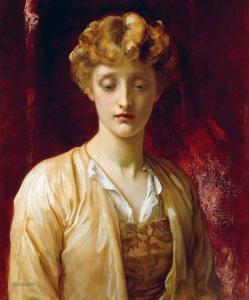 Around 1800. Frederick Leighton. "Miss Dene". Model Ada Alice "Dorothy Dene" Pullen.
Around 1800. Frederick Leighton. "Miss Dene". Model Ada Alice "Dorothy Dene" Pullen.
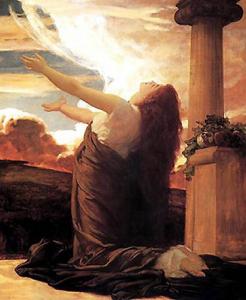 Around 1886. Frederick Leighton (age 55). "Clytie". Model Ada Alice "Dorothy Dene" Pullen (age 27).
Around 1886. Frederick Leighton (age 55). "Clytie". Model Ada Alice "Dorothy Dene" Pullen (age 27).
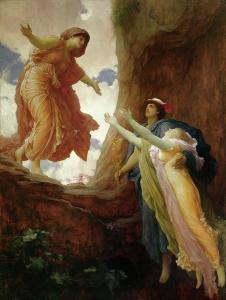 Around 1882. Frederick Leighton (age 51). "Return of Persephone". Model Ada Alice "Dorothy Dene" Pullen (age 23).
Around 1882. Frederick Leighton (age 51). "Return of Persephone". Model Ada Alice "Dorothy Dene" Pullen (age 23).
 Around 1882. Frederick Leighton (age 51). "Antigone". Model Ada Alice "Dorothy Dene" Pullen (age 23).
Around 1882. Frederick Leighton (age 51). "Antigone". Model Ada Alice "Dorothy Dene" Pullen (age 23).
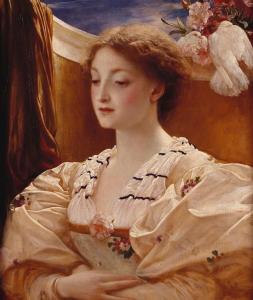 1862. Frederick Leighton (age 31). "Bianca". Model Ada Alice "Dorothy Dene" Pullen (age 3).
1862. Frederick Leighton (age 31). "Bianca". Model Ada Alice "Dorothy Dene" Pullen (age 3).
 1895. Frederick Leighton (age 64). Studies from Dorothy Dene for "Clytie".
1895. Frederick Leighton (age 64). Studies from Dorothy Dene for "Clytie".
And later:—
2 Holland Park Road, Kensington, W.
Dear Mrs. Barrington,—I want you to help me in a little conspiracy against (?) our young tragic friend. Mrs. Glyn frequently urges that she ought, at all events for a time, to give her whole mind and being to the study of her art. I need not say I share that opinion, and I have at last, after infinite trouble and persistence (my nose, you know)[76] induced her to leave off sitting for a month, in the hope, if you will all help, of making it a quarter. This would, I am confident, be of the greatest value to her, giving her time also to read a little and concentrate her thoughts. I am quite prepared to give up painting from her for three months; but she is in mortal dread lest her other friends should think her unkind and ungrateful for their sympathy. I have told her I believe no such thing, and that I feel sure that Schmaltz and you (who work most from her) will, as willingly as I, postpone your studies in order to aid her in so important a matter. She is going to call on you to-day; if you agree with me, be very firm—have a nose! Refuse to paint from her for three months.
Note 76. This referred to a joke we had had with reference to a photograph Mrs. Cameron had taken of my brother-in-law, Mr. W.R. Greg. Mrs. Cameron had insisted that all character, will-force, and superiority in general, evinced themselves through the size of the nose and the height of the bridge. The result was, in trying to accentuate this feature in my brother-in-law's photograph, she had made it almost all nose!
We succeeded in making the little girl work exclusively at her acting, and Leighton, Watts, and I frequently visited the school where she was being trained under Mrs. Glyn, to hear her and her fellow-students perform the pieces they had studied. Eventually she appeared in London and in the provinces, and quickly communicated all her successes and failures to Leighton and to me. Constant notes passed between us as we each received news from our young protégée, or when we thought some fresh step might be taken for her advantage. For instance, one of these notes runs as follows:—
Dear Mrs. Barrington,—It has occurred to me that I perhaps seemed this morning what I certainly did not mean to seem, churlish in regard to that letter from Irving.[77] If Miss Pullen is now ripe for him to hear her—this is the most important point (for to go to him too soon would be the most unwise thing possible in view of her getting a good engagement)—and if, having declined a letter on a previous occasion, she has any unnecessary scruple about now asking for one, it will be quite enough for you to tell me from her that she wishes for one, and I will at once write it. Kemp will always be able to tell you where to get at me. I can write as easily from Vienna or Constantinople as from here.
Note 77. Among Leighton's correspondence is the following interesting letter from Irving, who was an ardent admirer of Leighton's, and was among the first to join the committee formed to preserve his house for the public.
15a Grafton Street, Bond Street, W.,
January 1, 1889.
Dear Sir Frederic,—I am glad that you are coming to "Macbeth," and I wish you had been with us on Saturday.
The seats you wish for I enclose, though I should ever look upon it as a great privilege to welcome you myself.
Ellen Terry's performance is remarkable, and perfectly delightful after the soulless and insipid imitations of Sarah Siddons to which we have been accustomed.
You will find the cobwebs of half a century brushed away.
There is an amusing article in to-day's Standard, which overshoots the mark, and clearly shows how offensive it is to some minds to be earnest and conscientious in one's work. But I need not point this out to you.—Remaining, my dear Sir Frederic, yours sincerely,
H. Irving.
From Exeter Dorothy Dene wrote to Leighton after recounting an unwonted success:—
"Don't be frightened that I shall let all this praise turn my head. I know how much better it could be done, and after every scene a great weight falls on my heart that I have done no better. But I like you to warn me; it is good for me, so don't leave off, please. I am sorry that your friend, Lord Mount-Edgcumbe, will not see me, and that you had the bother of writing for nothing. Please do not fash yourself about finding out any one else. I must leave off now, as it is time to go to the theatre, and you will not get this any sooner if it were posted to-night than to-morrow.
Sunday, 24th.
"To continue, our lodgings are very comfortable, and nearly opposite the theatre; the food is good, and very fairly cooked, but I am very pleased with the tuck parcel; we had one of the birds when we arrived, the other things we have hardly touched. I thought it better to save them for places where the food may be bad. Please send me Mr. B. Tree's letter. I thought as you think about its advice. Thank you so much for your kind advice and gentle reminders, I shall try so hard to remember all you have said to me at different times; and if I do become anything in the future, I shall owe all the best part of it to you."
An engagement for two matinées was made for her début in London.
"Dear Mrs. Barrington, 'Dorothy' acts at the Globe on Monday and Tuesday afternoons," wrote Leighton; "I mean to go on Monday." I took a party of eight to see her, including the late Lord Lytton, who took much interest in the stage. After the performance Leighton wrote to me, "Poor Dorothy was paralysed with terror yesterday—but I hope intelligent people will have seen through that." Again, later, "she is adding, as she deserves, to the number of her friends, several of whom treat her with really maternal kindness." I can indeed very truly endorse Leighton's good opinion. Dorothy and three of her sisters were worthy of all the interest shown in them. They were entirely self-respecting, conscientious children, most affectionately devoted to one another, and striving their utmost to improve in every sense, and make themselves worthy of the help they received. Naturally they adored their chief benefactor, Leighton. Unfortunately, Dorothy, notwithstanding dramatic gifts, great perseverance and intelligence, lacked charm on the stage. Her very beautiful face and throat were not seen to advantage, as they were hardly in proportion with her figure, which was short and too stiffly set to move gracefully on the stage. Leighton in fun always called her "the little tee-to-tum," or when she wore a large hat, "the mushroom." As he felt vitality waning and mental effort a greater strain, the little family of Pullens had to Leighton somewhat the same resting charm that Italy had in early days, when he turned from the German austerity in study to the relaxation of the dolce far niente of Italian national life. "I go to see them," he used to say, "when I want to let my back hair down and get off the stilts." When Leighton was dying, his sister, Mrs. Sutherland Orr, took Dorothy into his room. He was too ill to speak, but only smiled to her in answer to her saying, "If I have or ever will do anything worth doing, I owe it all to you—everything I owe to you." It is almost unnecessary, as it is distasteful, to mention that this beautiful paternal attitude Leighton displayed towards these orphans was made the subject of ugly gossip—for are there not always the misérables of the world who seek the ugly rather than the beautiful? misinterpreting the beautiful so that it should come within the range of their scandalous arrows, more especially when the darts attack a man in the high position Leighton held. Some of these offshoots of envy and jealousy came within earshot of Leighton's sisters, who thought it well to warn him in a letter that such malice was in the air. He wrote a lengthy answer, ending with the following sentence: "But let me turn away from the whole thing, it has pained me more than enough. I implore you not to reopen it. On the only thing that matters, you are absolutely assured, if you believe in my honour. If you hear these rumours again, meet them with a flat, ungarnished denial. Let that suffice—it does for me." To a lady friend he wrote still more explicitly, in order, as he said, that there should exist in his own handwriting an implicit and unmitigated denial of the malicious falsehood. Leighton never knew under whose auspices this scandal was conducted. As is the case invariably, it was impossible to put the finger exactly on the culprit—for these fulsome things have to be propagated under the rose, in order that they should get a firm root before an authoritative denial can be given. However, after Leighton's death, the lie was stated more boldly—even directly to his two sisters. It is necessary, therefore, to include in the account of his life the full and truthful version of the kind and fatherly protection Leighton gave to this family.
The interests of the Kyrle Society were another cause which I had in common with Leighton. He spoke at the first public meeting that was held in the Kensington Town Hall on January 27, 1881, and I possess an interesting correspondence with him on the subject, which space will not allow me to quote. The important matter contained in it appears in the following correspondence between Mr. T.C. Horsfall, the chief mover in establishing the Art Museum and Galleries in Manchester, and Leighton, together with a discussion on other vital points connected with Art:—
April 7, about 1880.
Dear Sir,—I am probably too late to be of any use, but have nevertheless much pleasure in assuring you once again of the sympathy with which I view your endeavours to bring the refining influences of Art in all its forms, and, so to speak, in co-operation on the masses in the vast industrial centre from which you write. I believe that in seeking to elicit and to cultivate their sense of what is beautiful you are opening up to them a deep source of enjoyment, and by opposing good to bad influences, rendering them great and lasting service.—Yours very faithfully,
Fred Leighton.
February 17, 1881.
I have carefully read over the programme of your enterprise, and there is much in it with which I can warmly sympathise. I desire nothing more deeply than to see the love and knowledge of Art penetrate into the masses of the people in this country—there is no end which I would more willingly serve; but there is in your programme a paragraph which I cannot too emphatically repudiate—that, namely, which excludes from Art, as far as the public is concerned, that which is the root of the finest Art as Art, the human form, the noblest of visible things. That you should sternly and stringently exclude all work which reveals an offensive aim or prurient mind is what I should be the first to claim, but that you should lay down as a corner-stone of your scheme an enactment which would exclude by implication more than half the loftiest work we owe to Art—nearly all Michael Angelo, much of Raphael's best, Sebastiano del Piomba's "Raising of Lazarus," Titian's "Bacchus and Ariadne," Botticelli's "Birth of Venus"—this is indeed a measure from which I must most distinctly dissociate myself, and which makes it impossible for me to connect my name with an enterprise which would else command my sympathy.
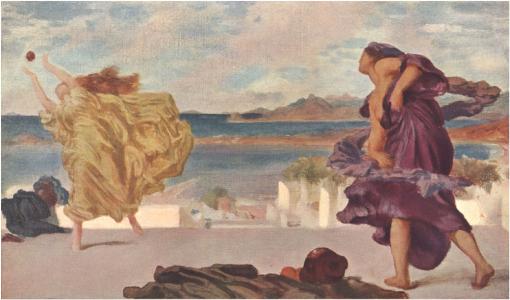 1889. Frederick Leighton (age 58). Study In Colour For "Greek Girls Playing At Ball."
1889. Frederick Leighton (age 58). Study In Colour For "Greek Girls Playing At Ball."
From the "Manchester Courier," August 30, 1890.
Sir Frederic Leighton on the Management of Art Galleries.
To the Editor of the Manchester Courier.
Sir,—On the 4th and 6th inst. I published two long letters on the management of art galleries, of some part of which this is a summary:—No one can intelligently and fully enjoy any picture or statue unless he has some measure of three kinds of knowledge. (1) He must know something about the subject represented, or he cannot enjoy the expression by the work of the artist's feeling and thought; (2) he must know something of the processes of the art in which the artist has worked, or he cannot know what effects the artist sought or might have sought; (3) he must know something of the history of the art, or he cannot understand what elements in the work are due to the artist himself and what to his time and place; or enjoy at all some of the finest works ever produced. For the giving of the second and third of these three kinds of knowledge there ought to be subsidiary collections in our Manchester galleries, kept distinct from the principal collection, and for the giving of the first kind there ought to be several distinct subsidiary collections, of which some should be for the purpose of giving knowledge of flowers, birds, trees, and the other beautiful objects which are "elements of landscape." As a very large proportion of the people of all large towns are ignorant of all that is interesting in nature, and of all that is noblest and most interesting in history and in contemporary life, and as pictures can very effectively give some knowledge both of nature and of the deeds of men while fulfilling their special function, which is to give certain kinds of æsthetic pleasure, the principal collections in our galleries ought to be used for the purpose of giving knowledge of nature and of noble human nature. A gallery of good pictures of the kind would, by reason of the interest of the subjects represented, attract so much attention that the public would to a far larger extent than now feel the influence of the artistic qualities of pictures. In order to obtain pictures of suitable subjects, the directors of art galleries, instead of only buying pictures in exhibitions and studios as they now do, should, as a rule, revert to the custom which prevailed in the ages when art influenced life deeply, and should ask artists to paint pictures of prescribed subjects. I believe that they would get thus better pictures and at lower prices. Many artists certainly would be at their best when they knew they were working to enlighten a great community, and would gladly accept a moderate price for a picture ordered for a public gallery.
I sent a copy of my letters to Sir Frederic Leighton, and asked him if he would let me have his opinion respecting the principal suggestions contained in them. With the great kindness which distinguishes him, Sir Frederic Leighton has written me the following letter, which contains advice so valuable that I am sure every person in Manchester who cares for art will be glad to have an opportunity of reading it:—
"Dear Mr. Horsfall,—I must apologise for my very long delay in answering your letter—a delay due in great part to lack of time, but in part also to the fact that your questions could not be answered hastily, or without due consideration. I may say at the outset that I very warmly appreciate the depth of your interest in the subject of art, and the constancy of your efforts to spread its influence in Manchester; and I am glad to be able to add that on not a few points, I find myself in harmony with your views.
"It is evidently not possible for me to touch, within the compass of a letter, upon more than one or two of the matters with which you deal in your two long communications to the Manchester press; and, indeed, the question on which you mainly dilate, and in regard to which I am not wholly at one with you, would require to be dealt with at far greater length than is possible to me here. I must content myself with saying what little seems to me sufficient to indicate the grounds of my dissent from you. But first I should like to say a word in passing on the vexed subject of copies.
"There can be no doubt that it would be an immense advantage to those who cannot travel—that is to say, to the enormous majority of men—to bring before their eyes, through reproductions—if these reproductions were absolutely faithful—the masterpieces to which distance deprives them of access. This is, in the case of sculpture and architectural detail, in a large measure achieved by the means of plaster casts, though it is needless to point out that the capacity of the material robs the reproduction of much of the life and light of the original. With pictures the case is different. The subtle and infinite charm which resides in the handiwork of a master, and in the absence of which half the personality of his work is lost, can hardly ever be rendered by a copyist. For this reason the overwhelming majority of even reasonable copies is to my mind worse than useless. Such copies can kindle no enthusiasm, and they virtually misinform the student. It has always seemed to me that the best way to acquaint young people with pictures which they are not able to see is to put before them photographs of the originals, which, besides giving design, form, and light and shade, with absolute fidelity, render, in a wonderful way, the executive physiognomy of the work; and by the side of these photographs free, but faithful, coloured sketches of the pictures should hang, giving the scheme, harmony, and tone of the colour, but not, like finished copies, professing an identity with the original, which is never achieved.
"Turning now to what you say on the subject of the acquisition of works for a public gallery, I should at once dissuade you from any idea of giving definite commissions—I mean commission to paint specially selected subjects. I have always felt very strongly that artistic work, to be of real value, must be the outcome of entirely spontaneous impulse in an artist. I believe that in the immense majority of cases work done under any other conditions lacks vitality and sincerity, and will not show the worker at his best. A subject which does not impose itself unbidden on the artist will never elicit his full powers. I have myself on that ground for many years past invariably declined to paint under any kind of restriction.
"Neither does your idea of—practically—refusing encouragement to any work which does not commemorate a noble deed, and, if possible, the noble deed of a well-known personage, commend itself to me. It seems to me, on the contrary, to be a harmful one, inasmuch as it misdirects the mind of a people, already little open to pure artistic emotion, as to the special function of Art. This can, of course, only be the doing of something which it alone can achieve. Now, direct ethical teaching is specially the province of the written and the spoken word. A page or two from the pen of a great and nobly-inspired moralist—a Newman, say, or a Liddon, or a Martineau—can fire us more potently and definitely for good than a whole gallery of paintings. This does not, of course, mean that a moral lesson may not indirectly be conveyed by a work of art, and thereby enhance its purely moral value. But it cannot be the highest function of any form of expression to convey that which can be more forcibly, more clearly, and more certainly brought home through another channel. You may no more make this direct explicit ethical teaching a test of worth in a painted work than you may do so in the case of instrumental music; indeed by doing so you will turn the attention of those before whom you place it from the true character of its excellence—you will, so to speak, mis-focus their emotional sensibility. It is only by concentrating his attention on essentially artistic attributes that you can hope to intensify in the spectator that perception of what is beautiful in the highest, widest, and fullest sense of the word, through which he may enrich his life by the multiplication of precious moments akin to those which the noblest and most entrancing music may bestow on him through different forms of æsthetic emotion. It is in the power to lift us out of ourselves into regions of such pure and penetrating enjoyment that the privilege and greatness of art reside. If, in a fine painting, a further wholly human source of emotion is present, and if that emotion is more vividly kindled in the spectator by the fact that he is attuned to receive it by the excitement of æsthetic perception through the beauty of the work of art as such, that work will gain no doubt in interest and in width of appeal. But it will not therefore be of a loftier order than a great work in architecture or music—than the Parthenon, for instance, or a symphony of Beethoven, neither of which preaches a direct moral lesson.
"But I am being led away into undue length without the possibility, after all, of doing more than roughly indicate the grounds of my dissent from a rather vital article of your creed—a dissent which will, I am afraid, jar on you in proportion to the great sincerity with which you hold your faith. I may say, by the way, that I dwelt at rather greater length on this very subject in my first presidential address to the Royal Academy, delivered on 16th December 1879.—And, herewith, I remain, dear Mr. Horsfall, yours very truly,
Fred Leighton.
"2 Holland Park Road, Kensington, "August 18, 1890."
Examples of the kind of copies which Sir F. Leighton recommends can be seen in the Art Museum in No. 1 Room. We have there a photograph of the "Adoration of the Magi" of Paul Veronese, with a series of studies by Mr. F. Shields of the composition, the light and shade, and the arrangement of colour in the picture. These copies suffice to prove that such a collection as Sir F. Leighton recommends would be of the greatest value and interest. May I say with regard to two points in the letter, that my proposal to use some parts of the collections in our galleries for the purpose of revealing the beauty of nature and the greatness of human nature, does not involve any belief that the giving of ethical teaching ought to be one of the functions of pictures, and that the proposal is made partly for the purpose of increasing the width of appeal of works of art. While trying to make that appeal reach a large part of the community, we may usefully teach, by means of other parts of the collections, that the excellence of paintings has no relation to ethical teaching.
With regard to the influence on the artist of the choice by others of his subjects, I think that Sir F. Leighton is misled by his own great gifts. A man of remarkably wide culture, and of great poetical power, he has been enabled, by the great range and strength of his imagination, to choose subjects giving ample scope for the exercise of the qualities peculiar to the painter, and yet appealing strongly to the powers of thought and feeling of all fairly educated people. To such a man, and to such a man only, spontaneous impulse can now be a sufficient guide in the choice of his subject; and to such a man, and only to such a man, the choice of his subject by other persons of intelligence would be a harmful restriction. In every picture gallery it is but too obvious that the majority of even able painters, though unrestricted by the will of any committee, are impeded by more hampering restrictions than any intelligent committee would impose, and are unable to find subjects interesting both to themselves and to others. For many able painters the intelligent choice by others of subjects for their work would remove, and not impose, restrictions. It must be remembered that the subjects of the works of Pheidias, of Cimabue, of Giotto, and indeed those of most of the works which have been much cared for, were chosen for, and not by, the artists.—Yours, &c.,
T.C. Horsfall.
The following letter is Mr. Horsfall's answer to the one published in the Manchester Courier, August 30, 1890:—
Swanscoe Park, near Macclesfield, August 20, 1890.
Dear Sir Frederic Leighton,—It is most kind of you to answer my letter so fully. I shall show my gratitude by doing my best to make your counsel as useful as possible to Manchester.
The system which you suggest for giving some idea of masterpieces which are too distant to be visited seems to me to be admirable, and I cannot but believe that it will be adopted in one of our Manchester Galleries.
With regard to the advisableness of choosing for public galleries chiefly pictures of noble subjects respecting which most people have, when they see the pictures, or can be expected to gain, some knowledge, though I feel the great weight of your argument, I am still of the same opinion. I may say this without presumption, because the great question which we are discussing: "How can Art be made most useful to England?" involves the two other questions: "What are the best conditions under which artists can work?" and "How can the best work of artists be made to influence the rest of the community?" In considering the second of these questions an artist is, I think, impeded by his special gifts, while I, not an artist, aided by the qualités de mes défauts, and by the results of several years of experiment in the use of pictures, believe myself to have gained much trustworthy knowledge! Speaking from the standpoint which I have thus reached, I should say that whilst the artist is most conscious of the analogy which exists between painting and instrumental music, there is really a much closer analogy between painting and poetry, or between painting and song, and that it is this closer analogy which should guide the action of the directors of public galleries. Painting deals, while instrumental music does not, with subjects respecting which we think and feel, and it must accept the results for good and evil of this; its products cannot be, as instrumental music is, without definite relation to our feeling and thought, and a simply neutral relation being impossible, the relation must be ennobling or debasing in some degree. I think that my analysis of the conditions which must be fulfilled if the relations is to be an ennobling one was sound.
In asking that painters shall choose subjects pure and lovely "and of good report," I am not asking that painting shall leave its special function—shall cease to do that which it can do better than any other art; but only that it shall recognise that its function differs from that of instrumental music, and is the creation in us of a symphony of feeling or emotional thought and enjoyment of form and colour, and human skill, and love of beauty.—With very many thanks, I am, dear Sir Frederic Leighton, yours sincerely,
T.C. Horsfall.
2 Holland Park Road, Kensington, W., August 22, 1890.
Dear Mr. Horsfall,—I have to thank you for your kind and interesting letter of the 20th.
Knowing of old the views you entertain, and the radical divergence which exists between them and my own, I had fully anticipated the spirit of your answer; in fact, it almost seemed to me when I wrote at some length the other day that I ought to explain that it was out of deference to your wish and in high appreciation of the long and earnest thought which you have given to a grave subject that I did so, rather than in the hope that my views would carry conviction or commend themselves to you.
The divergence between us is, as I said, at the root of things, and is one on which I do not think experience either qualifies or disqualifies us to judge. The question is not what effect pictures may have had on certain people, but what the proper function of Art is. The question is theoretic rather than practical. If the primary function of Art is definitely didactic, if its first duty is to inculcate a specific moral truth, then, indeed, there is, as you very rightly say, no neutral ground. Either the teaching is wholesome or it is mischievous.
Meanwhile, our brief correspondence only throws into stronger light the impossibility to which I believe I alluded in my first letter, of dealing with such a subject within the compass of a letter, and in broad and sweeping outlines. So, for instance, when I used instrumental music as a parallel, I did not for a moment mean to describe its province as being identical with that of painting. Neither, on the other hand, would you, I presume, in instancing song on your side wish to be taken too literally; for you would have, according to your theory, to excommunicate, let us say, for instance, Schubert, the king of song-writers, who has played on more varied chords of feeling and imagination than any other musician of his kind, and of whom I am not aware that he ever inculcated (I feel pretty certain that he never meant to inculcate) a definite moral lesson.
But I am beginning again. Let me at once draw rein, and abandoning a barren, however interesting controversy, remain, dear Mr. Horsfall, yours sincerely,
Fred Leighton.
2 Holland Park Road, Kensington, W., August 28, 1890
Dear Mr. Horsfall,—Before starting for my holiday, of which I stand in much need, I write one line to acknowledge and thank you for your amiable and interesting letter, which shows me, I am very glad to see, that we are much less divided in opinion than I should have gathered from what you had previously written, and indeed printed.
Judgments given as absolute in your letters to the Manchester press are shown by the commentary which your last letter furnishes to be in a manner conditional, and without that commentary your words were rather misleading. I was not unnaturally a little startled—I, who do not think a "subject" in the ordinary sense of the word imperative at all—to find you condemn the purchase of Yeames's "Arthur and Hubert" (which, for the element of human emotion, certainly satisfies the Aristotelian demand in reference to tragedy), because the emotion does not turn on an heroic act; and I may say, in passing, that I am unable to see how a scene in which deep pity for the helpless is aroused, can be justly described as a "horror which it is foolish to try to realise."
Meanwhile, I fully feel the practical difficulty which your last letter describes. It is a difficulty of the most perplexing kind. For it must be evident that whilst with a people of strong moral fibre and an almost entire absence of æsthetic sensibility—at all events, on the side of form—you may indirectly insinuate some perception of the beautiful—of that essence which lifts us out of ourselves—under the cover and pretext of a moral emotion—we cannot ignore the danger of producing the exactly opposite effect of confirming the dully-strung spectator in the belief that the stirring of that moral emotion is in fact the raison d'être of the work. One is, of course, glad, as the world goes, that the doors of righteousness should be opened, even by the wrong key; but one would still more desire that the door which yields only to that key should not itself remain closed.
Pray do not take the trouble to acknowledge these parting words: but believe me, very truly yours,
Fred Leighton.
With regard to Leighton's acute artistic sense of fitness when it was a matter of chosing a site for buildings or monuments, so that such placing should give them their full value of effect, I remember, after a site had been decided on for Cleopatra's Needle in London, Leighton vehemently denouncing the idea of placing it where it now stands. The conversation we had respecting it was recalled by finding the following letter:—
Dear Sir,—It is a source of regret to me that I am unable to be present as a listener at the discussion to-morrow. Meanwhile the question of the base, though a very important one, is in my mind very secondary to that of the site, and the (in my poor opinion) radical wrongness of the present selection much mars my interest in the whole affair. A monument which, intended to be conspicuous, is not the focus of the avenues that lead to it, I think against the most primary perceptions of effect. Two magnificent avenues give access to Cleopatra's Needle, the finest river and the finest embankment in Europe; both of these run past it as if they had forgotten it. I may add that what would only have been feeble is rendered worse than feeble by the (of course accidental) semblance of matching with the short tower over the way.
Pray excuse the great haste in which I write and the consequent abruptness of my expressions, and believe me, yours very truly,
Fred Leighton.
Mr. J. Goodall, in his Reminiscences, says: "Many years before it was removed from Egypt I used to see it lying on the seashore near Alexandria. I agree with Lord Leighton's opinion that it was not erected on a suitable site. It is a pity it was not put up in front of the British Museum."
Leighton, needless to say, took infinite interest in Sir Henry Tate's splendid scheme for memorialising the success of a commercial life, by presenting to his nation a gallery in which the best British works of art might find a home, and, moreover, by the gift to the public of the nucleus of such a collection. It was truly amazing to see the amount of time and trouble which Leighton devoted to this scheme, considering how full to overflowing his life already appeared to be. But, whether it was a question of a splendid enterprise, or a struggling artist of whom the world had never heard, or even an earnest amateur, once his sense aroused that he could be of help, Leighton manufactured time somehow to give that help.[78] But the high-minded, public-spirited view Sir Henry Tate took of the responsibilities of wealth specially enlisted Leighton's sympathies, and he evinced an intense interest in helping to work out the great idea.
Note 78. Needless to say that time was invariably forthcoming to welcome and entertain the friends he loved. The following letter from Costa gives a picture of his delight in so doing:—
London, Dec. 10, 1888, 2 Holland Park Road.
"Dearest Tonina,—A thousand thanks for the twelve letters which I have found awaiting me here.
"I have just arrived from the station, where I found the President, who was shedding light all round him, all radiant with his white beard. Note that the train arrived at a quarter past five, and there was an hour's drive from the station to his house, and then he had to dine, and at half-past seven he was due at the Academy for a distribution of prizes to the students, where I, too, was to have accompanied him. However, in London there was one of those fogs which put a stop to all traffic, and it took us an hour and three-quarters to reach home.
"The cabman had to get down and lead the horse; with one hand he guided the animal, which was slipping on the ice, and with the other he held a lantern. What darkness,—the gloom of hell itself! Boys holding torches and shouting, showed us the way; foot passengers called out, 'Hi there! look where you're going to!' but, in spite of everything, the cabman with his lantern banged into a railing.
"At last we arrived at our destination, having discussed all the way along the speech which Leighton made at Liverpool. The dinner was ready, and eaten hurriedly, with the obligatory champagne. I had eaten nothing since the morning. Whilst dining, I got off accompanying him to the Academy, pleading my rheumatic pains, and I ate like a famished and attentive dog. But the President, spite of the hurry he was in, never once ceased from tracing the iron line along which I am to run as long as I am with him, and so he has set me down for a trip on Saturday.
"Good-night; I am going to bed, as I am deadly sleepy. Did you receive a letter of mine from Castle Howard?
"Thank for me the kind writers of the twelve little letters; in the midst of these fogs they have been twelve stars to me. A kiss to dear Tonachino. Frederic was much amused by Georgia's letter, and embraces you all.
"Love to all, from Ninaccio, who has the greatest possible desire to repass the Channel."—(See "Giovanni Costa: His Life, Work, and Times," by Olivia Rossetti Agresti.)
Another matter which concerned him very seriously was the fact that a work by the greatest sculptor England can claim—Alfred Stevens—purporting to memorialise our great warrior, the Duke of Wellington, was allowed to remain unfinished and shunted away in a side chapel of St. Paul's Cathedral, instead of being completed and placed in the position for which it was designed. The following letters to Mr. Henry Wells show that in 1888 Leighton had induced others to view the matter in the same light:—
2 Holland Park Road, August 12, 1888.
Dear Wells,—The list for the Memorial Committee is practically complete, and though it is not in every particular the list which you or I might have drawn up, it is a good one, and as I told you I think in a previous note, I have not liked to interfere too much, as Agnew has so zealously taken the work on himself. I meant to send you the list, but have cleverly come away from home (I am writing at the Senior United Service Club) without it. I have of course asked Agnew to add his own name; for the Academy I have proposed to him the four Trustees—not as Trustees, but because they offer a ready-made group in a body where none is afore or after—Sir J. Gilbert, Linton, and Coutts Lindsay will complete the artistic section for the present. The next step, as I have suggested to Agnew, is to get at the Dean of St. Paul's—this I have offered to do. A chairman will have to be appointed; I should suggest, or rather have suggested, the D. of Cleveland—if he joins; I believe his answer has not yet come in. And there must be a banker: then a letter from the Committee should appear in the Times inviting adhesions and subscriptions, to be published from time to time: is all this in harmony with your own view? Are you not afraid that the moment when "everybody" (for our purposes it is everybody) is leaving town or has left it—I go myself in a few days—is a very bad one? Many people lose sight of their Times, or would not write from the country or foreign parts. How would it strike you to wait a month or two, having now laid the foundation? It is a nice point. There are pros, but there are also cons. With all good wishes, yours sincerely,
Fred Leighton.
You have seen no doubt in your Times that we mean to exhibit our lamented friend's work in a worthy manner.
P.P.S.—By-the-bye, S. Kensington ought to be represented. I will ask Agnew to write to T. Armstrong.
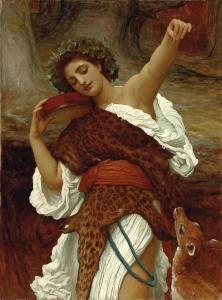 1892. Frederick Leighton (age 61). "Bacchante".
1892. Frederick Leighton (age 61). "Bacchante".
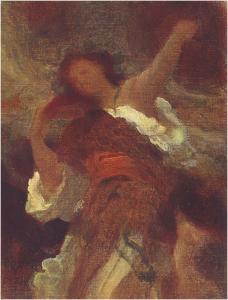 1892. Frederick Leighton (age 61). Study in Oils for "Bacchante".
1892. Frederick Leighton (age 61). Study in Oils for "Bacchante".
2 Holland Park Road, Kensington, W.,
November 2, 1892.
Dear Wells,—Best thanks for your cheque and kind note. You will be glad to hear that the removal is going on capitally. I did not wait for the full money-promise; I had determined to do the thing, and I set it going on my personal guarantee when we were £300 short of the full sum. Now we have the money, young Lehmann munificently sending a cheque for that amount.
The great monument having been moved to its right position, the next question was to raise funds for the completion of the work. This was perplexing Leighton during the last weeks of his life. Having written a letter to the Times in 1895, and the donations having come in but scantily, he was puzzled to know what further steps to take.
Leighton himself, so distinguished a sculptor, took a special interest in all efforts to promote the knowledge and love of plastic art. When, therefore, his old friend Mr. Walter Copland Perry called a meeting at Grosvenor House—at which the late Duke of Westminster presided—to lay before it his scheme for the formation of a gallery of casts from all the best Greek and Roman statues, Leighton was one of the most zealous and active promoters of the scheme.[79]
Note 79. It may interest his friends to know that the valuable collection of casts which Mr. Copland Perry spent four years in forming, after visits to all the collections of ancient sculptures in Europe, has been ceded to the British Museum, and will be transferred from the South Kensington Museum, where it has long been hidden away in a dark corridor, to suitable courts in the new buildings of the British Museum.
Leighton was commissioned by the Government to execute the medallion for Queen Victoria's Jubilee in 1887. M. Edouard Lantéri, now Professor of Modelling at the South Kensington schools, assisted him in carrying out the design, and became an ardent admirer of the President. M. Lantéri described to me how certain difficulties occurred in the casting. Leighton said they must work on till these were set right—and they did work eighteen hours on end.
All to whom the work of Watts, Burne-Jones, and Rossetti has appealed, owe Leighton a debt of gratitude. Before the Grosvenor Gallery Exhibition of his work took place in 1882, Watts, in talking to me of the unpopularity of the pictures he felt most inspired to paint, would often give as a proof of this that, with one exception, no one had ever cared to engrave his pictures; and truly, without Mr. Fred Hollyer's photographs the general public would have known little of the special value of this work, nor of the art of Rossetti and Burne-Jones. Mr. Hollyer's photographs are not merely copies—they have as art an atmosphere of charm in themselves; they render what may be called the soul of a picture. He writes:—
"About 1875 I received a letter from Baroness ——, requesting me to call upon her in order to arrange to photograph the collection of works of art in her country house. She had employed other photographers, but the results had not been satisfactory. I carried the matter through, and not only received a considerable amount in remuneration, but was given great encouragement to persevere with my work at a time when I had nearly decided on going to America. The Baroness never mentioned who it was that had recommended me, and though I had been constantly working for him during many years, it was not till six months after his death that I discovered it was Lord Leighton who had been my good friend. I should be glad to bear testimony to his great heart and loving kindness, and do regret not having been able to thank him myself."
Leighton was made a Baronet in 1886. The following letter from Gladstone, written in 1885, refers to Leighton having submitted to him the names of Millais and Watts as artists worthy to receive the honour, at the same time begging him earnestly not to include his own:—
Private.
10 Downing Street, Whitehall, June 17, 1885.
My dear Sir F. Leighton,—Your letter has given me much pleasure. I can assure you that I in return highly appreciate the generous spirit you have shown, and I value the advice you kindly tendered in this matter of Art Honours. I am reporting rather fully to Her Majesty on our conversation of Monday, and on the personal abnegation on your own part, which commands my cordial respect.—I remain always, very faithfully yours,
W.E. Gladstone.
On Watts declining the honour, Leighton was at first much vexed; but Watts, having explained to him the reason which made it inadvisable for him to accept a baronetcy, Leighton fully, as he told my husband and myself, saw the necessity of his declining.
Since the first years when Leighton settled in London he had been favoured by the personal friendship of many members of the Royal family, who very greatly esteemed him. He not only attended the State banquets and entertainments to which he was summoned, but was frequently the guest at receptions of a private and a more intimate character at Marlborough House and elsewhere.
In these pages there is only space to note a few, among the very many directions in which he served the Art interests of his country. In foreign lands, and in the Colonies no less than in England, he extended the knowledge and appreciation of the best English Art by his unwearying exertions; and yet it must always be remembered he ever remained "a workman first, an official after."
Professor Church, appointed in 1879 to the Professorship of Chemistry in the Royal Academy of Arts in London, has preserved letters and notes from Leighton on the subject of pigments.[80] It is almost incredible that his mind could have penetrated with such accuracy into all the details of his craft as fresh questions arose as to the value of new vehicles and colours, considering his endless labours connected with the wider interests of Art, and the absorbing nature of his own work. But there exist over sixty letters, and more than twenty cards, dating from 1880 to November 1895, two months before his death, in which he proves his insistency to master thoroughly every detail of his craft. He wrote: "It is, I feel, rather a duty in me to ascertain about these various new vehicles."
Note 80. Professor Church's Lectures were given to the outer world beyond the Academy in the form of a book, published in 1891, and dedicated by permission to Leighton.
The following extracts may prove of interest and value to painters.[81]
ydWop8i08th
Dear Prof. Church,—I write to acknowledge your letter of the 6th, the information in which (Jaune de Naples) is to me of very great importance indeed. I believe Hills to be really anxious to help us in the matter of medium. I should be peculiarly glad if we could send forth a thoroughly trustworthy, hard-drying, supple, and not yellowing vehicle. Let us consider it. I find myself using a mixture, roughly, of equal parts of amber varnish (Roberson's) and oil of spike; and, say, a sixth of the whole of poppy oil (Roberson's): that is, 3/7 amber, 3/7 spike, 1/7 poppy; but I vary according to the work; and again I don't know what Roberson's amber varnish is, it does not seem very drying. Of course one would want a good middle drying power, to which, mixing the ingredients, one might add any one at will. I think that "Siccatif de Haarlem" has about that middle quality, if I remember it rightly. It is, I think, copal, poppy oil, and turps.; but it seemed to me to yellow a little, why, I don't know; poppy should not darken. Chromophile is delightful up to a certain point, and then the work sinks extraordinarily blind and tallowy; and as you want something in the way of varnish at the end, it seems desirable to carry that or some varnish in a moderate degree right through. Chromoph. becomes a little milky in a bottle with spir. of turp., and turns bright green when left in a dipper.
Your proposal to report to us annually is very valuable, and could be worked to the general advantage.
Note 81. The questions raised in these letters have been very fully answered in the third edition of Professor Church's "Chemistry of Paints and Painting" (see Index), published in 1901.
I am delighted to find that you are in co-operation with my friend Mr. Hills, who has a warm and genuine desire to serve Art and his friends the artists. I find his poppy oil clarified with charcoal very delightful stuff. Am I wrong in thinking the action of the charcoal on it has been to render it more drying? I think that a vehicle made with that oil, amber varnish, and oil of spike will be a very satisfactory vehicle indeed; particularly if you can, between you, bleach the oil yet more. Chromophile is quite colourless. The mastic varnish that won't bloom will be a great triumph. Pace our detractors, it shall, I hope, be seen in time that the R.A. is not unmindful of the needs of artists even in the matter of material appliances.
I observe that you speak in your valuable manual of Aureolin as a very slow-drying colour when ground with oil; finding, in use, that Roberson's Aureolin dries, on the contrary, extremely quick—it is always absolutely dry the next day, and I use no vehicle but Bell's Medium, i.e. linseed and oil of spike and turps.—I wrote to ask him what he grinds the colour in. He answers "pure linseed oil without the addition of any drier." This puzzles me. Where is the solution? Are there different kinds of Aureolin? When you have a leisure moment send me a post-card.
Among the madders in your handbook scarlet madder does not appear; I hope it is not a treacherous colour; I use it freely, but only mixture with other dark colours, to give them richness. I also use cadmium red; is that wrong? A line on a post-card will greatly oblige.
P.S.—Of course I only use cadmium red when I want a very deep orange in drapery or sky—nothing could replace it.
Feb. 2, 1885.
Here is a little problem: I thought all burnt colours were ipso facto sound. Roberson tells me that burnt white (Chremnitz do.), a lovely colour like ivory, plays most amazing tricks, darkens and lightens again in rapid succession. WHY? When you are in Long Acre make him show you his samples.
Thanks for your letter. I don't use any particular colours other than those you mentioned in your lectures, although I thought of trying deep yellow madder again; I used to like it very much. I suppose you have the list—it is a very long one—of Edouard's colours. Smith is his agent here (14 Charles Street, Middlesex Hospital). I use one or two colours (Tadema I think all) from Mommen's in Brussels; his burnt sienna is superb. Asphaltum would reward study; it was universally used by the Venetians, and seems never to have cracked with them. I am very glad that you are steadily pursuing your collection of specimens and experiments, which I hope will by degrees become an exhaustive one, and of infinite value to the profession. Grounds, too, will deserve much attention.
Kindly tell me whether there is any harm in putting a thin coat of mastic, softened perhaps with a drop or two of oil, over works finished quite recently but begun a year or more ago? If I understand rightly, cracking is caused by atmospheric action through the back of the canvas, by distension of underlying partially soft paint and, consequent disruption of the upper, harder layer of varnish. If the first painting is a year old, is it not tough enough to resist the atmosphere, and is it not anyhow pretty safe when the canvas is backed?
I suppose "Mutrie yellow" is quite safe alone and mixed with other pigments?
Thanks for your note. Yes, I do like the white oil, but I add copal to it if I want it to be very drying, or mix copal on the palette with a slow-drying colour, say a lake. This, I suppose, is all right; if so, don't trouble to acknowledge this. The oil of orange is delightful on account of its smell, but dries less quickly than turpentine (rectfd. spirit). Is it not always better to have some resin in a picture throughout since it has to be varnished at the end?
April 21, 1888.
April 21, 1888.
I am so much enamoured with the method, so far as vehicle is concerned, which I have used during the last year, that I should like to feel quite certain that it is absolutely safe. I use a "single-primed" canvas, and underpaint with "Bell's medium" and rect. spir. turps., which, under your advice, I have in small bottles, so that using it freely a bottle lasts a very short time, and the stuff is therefore always fresh. The mixture I use up to the end (except when I now and then use the pigment alone), and letting the turps. rather preponderate as I advance. I have found to my amazement that this mixture dries even in winter weather excellently, and that I can use with it even scarlet madder and aureolin, which, at least the former, hitherto I never attempted to use except stiffened with amber or copal; and I further find that this mixture, though of course it "sinks" to some extent (and especially with the blues), in the main bears up very fairly, incomparably better than I should have expected, and in fact quite enough. Before beginning to paint I rub over the part each time with Bell's medium and saliva nearly equal parts, or say five oil to four saliva beaten up with the knife on the palette to a white mucilage. This, if left alone, makes a good varnish, and is delightful to paint into. So far, so good; at least I suppose so. (Do you see any elements of danger? cracking? darkening?) But at the end something must go over it all, if only to lock it up (I suppose), certainly to get uniform gloss and strength. I propose in the Academy to put Roberson's medium over the whole of my large one and to retouch with the same. A portrait on to which I don't intend to work I should cover with mastic and a little poppy oil; there is no harm in this, I suppose, and the small quantity of mastic is not likely to yellow, is it? I know this mixture won't come off, but why should it?
May 30, 1889.
Messrs. Reeves send me a colour in which I delight, but which I have hitherto always avoided as being unsafe, to wit, indigo. I suppose one ought not to use it, ought one? although my old friend, and in some ways my master, Robert Fleury, employed it extensively in underpainting blue draperies.
December 23, 1889.
I have got a recipe—a very simple one—from a friend of mine in Italy, who paints a good deal in distemper, and who in technical matters is quite the most leery person I ever came across. In this recipe he mentions what he calls "Gum Damar," which he, in his characteristic ignorance of spelling (for Italians are not very strong in orthography), writes with an apostrophe, D'Amar. Now I presume he means "Gum Dammar" (I believe there is such a thing, is there not?), but I should like to feel sure. Perhaps you will kindly enlighten me on a post-card.
The distemper itself is the simplest thing in the world. It is only a proportion of water and yolk of egg (he deprecates the use of vinegar), to which he adds a certain number of drops (I have not the recipe by me) of this gum. Of course it would be important not to use the wrong gum. Hence the trouble I am giving you.
January 27, 1890.
I have just received from Perugia the enclosed sample of Gum Dammar, which you were kind enough to say that you would report upon to me. A few drops of this (by-the-bye, I do not know how it is to be dissolved) and the yolk of an egg stirred in water, form the distemper used by my friend Mariani.
I don't know whether I told you that he is rather an interesting fellow. He is one of those extremely dexterous Italian workmen-artists who know and can work in every material, and whose forgeries of sixteenth century bric-à-brac, cassoni, reliefs in pastiglia, &c. &c., have, I am afraid, not infrequently been purchased as original by very crafty persons.
Several friends of mine who use distemper, and he amongst the number, tell me that by putting a preparatory coating of distemper over thoroughly dry oil, you can with perfect safety interpose a layer of painting in distemper between two paintings in oil—an extremely valuable thing for us for recovering quality.
January 31, 1890.
Many thanks for your valuable letter. I have had the information entered in a little book, where I keep the outpourings of your wisdom on matters chemical.
Thanks also for the card, in which you give me a somewhat long name for my Gomme Dammar. I suppose in an appeal to a chemist the first portion would suffice.
February 14, 1890.
Many thanks for your valuable note. I may say in passing that the specimen of "Ruby Madder" sent by Mr. Laurie appears to me to be inferior in brilliancy to both the Rose Madder and the Madder Carmine furnished by Messrs. Roberson; and I have no reason to doubt that the latter colours are perfectly trustworthy.
It will give me great pleasure to receive the dedication of your book, which I look forward to seeing with pleasure, and using with profit.
May 19, 1890.
Many thanks for your note, which seems to open up an interesting point. I gather from what you say that the mode of manufacture of a colour may affect its drying properties over a range extending from drying very slowly to drying very rapidly; and I shall be much interested in hearing what your experiments lead to under this head.
January 30, 1891.
Many thanks for your letter. I see that I had better wait for a final opinion until the few months have expired which you still require as tests of permanence. Meanwhile, I am a little unhappy to see in the case of colour after colour the expression "semi-permanent." I do not quite know what that means. Let me know at your leisure whether it means permanent under certain conditions, and, if so, what; or merely in a general way that the pigment stands, but only pretty well. The Rosso Saturno I quite understand is to be set aside.
Another perplexity is in regard to the Burnt Madder. If the madders are in themselves sound colours, as I have always understood them to be, how do they lose their permanence by burning? I should like to use the Gialetto, and I rather gather from what you say that I may do so. I hear with interest what you tell me of your new varnish. As for myself, I have got to dislike the use of any resins in my work to such an extent that I have completely set them aside. Of course when a picture is finished it requires some gum, not only to protect it, but to bring up the colour to its full value. Will you let me know—but this will do at your leisure, for the time has not come yet—whether a picture being painted as I paint mine, exclusively with Bell's medium and turpentine from first to last, and, I may add, worked on up to the last moment of sending in, i.e. a fortnight later, may on the walls of the Academy be safely varnished with this new material of yours, either alone or diluted with a little poppy oil? I look forward with interest to Heyl's Madder Green.
December 5, 1891.
I shall certainly try the Heyl's Madder Green, which I hear of through you for the first time. Laurie's daffodil cadmium is very pretty. I have got some; but my new delight now is yellow cobalt, which you have found to be absolutely safe, and which is absolutely delightful as a colour.
My tempera is come from Italy, and I am told that it is made of the tails (feelers?) of the cuttle-fish (sepia). Would you like to look at it again from curiosity? I understand that with the reservation that it darkens, I may use it with impunity in, under, and with the oil—that is enough for my purpose.
October 16, 1894.
Will you kindly advise me on the tempera, of which I send a tube? It is used by my friend, Prof. Costa, who gave it me; he likes it vastly. It coalesces with oil; he uses it also by itself between two paintings in oil. I have often longed for something to keep down the greasiness and slipperiness of oil paint when correcting or going over a surface often, oil and water do coalesce sufficiently. The most luminous thing I ever painted (and it has stood like a rock) was painted (or certainly thickly underpainted) with a vehicle made of starch and oil. What this medium is, I don't know. Please advise.
March 7, 1894.
Forgive secretary again.
I am much obliged by your note, and read with great satisfaction what you say about Newman's golden ochre. I shall now, until I hear from you further, adopt the motto "Ex uno disce omnes," and assume that the yellow ochre is equally sound and serviceable; although the colour is so much finer than any yellow ochre of my acquaintance that I cannot quite close my mind to a lurking suspicion that it is stimulated or refreshed by some foreign ingredient.
March 13, 1894.
Many thanks. You send me good tidings. The yellow ochre is by far the finest I have ever seen.
I enclose, because we think (Watts and I) that it will interest you, a specimen of purple lake (not madder), such as Watts has used all his life, which has been baking in the sun for two years; it is slightly browner, but more beautiful than ever, and has, you see, retained its full body; this is remarkable.
June 22, 1894.
Very many thanks for your interesting and exhaustive investigations on the French lakes. I observe that in several cases you mention lakes having cracked. I presume, however, there is no reason to suppose they would do this when embodied with other colours, and that if otherwise safe they might therefore be used. The purple lake used by our friend Watts is furnished to him, I have always understood, by Messrs. Newton of Rathbone Place. I am glad to hear so good an account of the pale boiled linseed oil from May & Baker, Ltd., of Battersea. I do not, however, gather from what you say that there can be any reason for substituting it for Bell's medium, to which I am much attached, and which, as you know, is, with the admixture of one-third rectified essence of turpentine, the only vehicle I use. This note, of course, requires no acknowledgment—anything you may have to say on these various points will abundantly keep until I get a further account of your investigations on the purple lake.
Many thanks for your valuable caution. Amongst the lakes you tried, did you include the garance nuance brun and do. brun foncé? Both are superb colours, and it would be nice to think one might use them. It is very comfortable to feel that one has a conscience one can tune at Shelsley.
April 19, 1894.
I am about now to take up a large decorative painting for the Exchange, a work which cannot be done on the spot on account, inter alia, of the darkness of the place, and will, therefore, be carried out here at the studio on canvas, and then "marouflé" on the wall. Macbeth (A.R.A.), who is also doing one, is using Parris's "Marble medium," in which, a thousand years ago, I painted two figures for mosaic at South Kensington; great brilliancy is obtainable, but I rather fear a certain tendency to look waxy and almost shiny. I myself incline to use Gambier Parry's material, which I have used on the wall at South Kensington and greatly like. But now the question arises, ought the canvas to be prepared? and on this I shall be grateful for your opinion, as the matter is very important. G. Parry told me that canvas either could or should be prepared for his medium, I don't remember which. Roberson's man tells me that Madox Brown and Fredk. Shields (I think) both had canvases prepared for a similar purpose. I shall postpone ordering mine till I have your instructions; till when, and always, I am, in much haste.
April 23, 1894.
Many thanks for your letter. I shall, of course, obey your instructions punctually, and substitute paraffin wax for the ordinary Brecknell and Turner beeswax, as prescribed by Parry himself. I will see Roberson immediately, for I should not think it right, as he ground the colours and prepared the medium throughout for my two large frescoes at South Kensington, to abandon him in favour of Laurie, or anybody else.
You suggest that I should make a little experiment on a small canvas. Do you think that would be necessary? I presume that the material will work exactly as it did before, and that the [300]surface will be—bar the granulation—very much the same as on a wall. I ask this question, because I ought to get to work immediately, and I gather from a reference to your work that it will take several weeks before the process of preparation is complete.
I wish I could throw light for you on the verb "maroufler," and should like to know what subterranean connection there is, or can be, between it and the word "maroufle" which is, as you say, being interpreted, a "rascal."
At all events, when the moment comes for the operation, I must endeavour to obtain information from France, where the process is in very frequent use.
February 27, 1895.
A contretemps has occurred of which I think I ought to inform you, as it relates to the very interesting subject of grounds and pigments.
Robersons, when they came to roll up my fresco to transport it to the Exchange, found that either the ground or the pigment—probably both, as they are of the same substance—was extremely brittle and cracked right across, cracking at a rather abrupt tangent from the circumference of the circle; so that they immediately struck work, and declined to go any further.
As far as the painting itself is concerned, I do not believe that any serious damage is done, because on re-straining it flat, the cracks are barely perceptible, and probably would not be at all perceptible in situ.
Meanwhile, if any question arises as to the ground, it has occurred to me, and it is on this point I wish to consult you, that the cause may be the substitution of paraffin wax for the ordinary wax hitherto used in Gambier Parry's material, which, though perhaps not absolutely so durable as paraffin, is sufficiently so, and very malleable. One does not see what else could have cracked in that abrupt and sharp manner—certainly not the copal, which has oil in it and is further made supple by the oil of spike. If it turned out that the paraffin was the peccant element, I should be, entre nous, rather glad, because it diminished the facility of the work.
With reference to the cracking of this work Professor Church writes:—
This unrolling was begun in very cold weather; if the temperature had been a little higher, nothing of this kind would have taken place. The picture now shows no sign of defect or injury, and is in perfect condition. By substituting ceresin, a paraffin obtained from ozokerite or earthwax, for crystalline paraffin, the chance of cracking is obviated. The ceresin, which should have a melting-point of 150° or 160° Fahrenheit, constitutes a safe substitute for the beeswax commonly employed in Gambier Parry's Spirit Fresco Medium.
Foggia, October 15, 1895.
You will be surprised to get a letter from me with an Italian superscription; I am writing thus early before my return to save time. When I was in Venice the other day, Van Haanen spoke to me, with approval, of a certain vehicle, of which I had already heard before vaguely, the invention of the French painter, Vibert. You probably know of it, as the subject of media has occupied you. There are, it appears, three forms of this medium: the vehicle for painting, the medium for painting into in retouching, and the final varnish. As far as I understood Van Haanen in a hurried conversation—he was a little vague—the painting medium contains no gum, only, he seemed to think, petroleum and oil; I assume that in the final "vernis" there is gum of some kind.
I am perfectly satisfied with Bell's medium and fresh turpentine for the very little use I make of vehicle in painting; but there is always the difficulty of the final varnish in the Academy. I don't like risking mastic or copal so soon on work which contains nothing but oil (and if I ever do use a little, I put poppy oil with it), and the result is that I generally varnish with Roberson's medium, which is safe, but I fear a little inclined to yellow in time.
Now what I want you kindly to tell me, my dear Church, is the exact composition of the three Vibert media, and your opinion about the safety of using all three in the prescribed order; and this I should like to know on my return at the beginning of November (hence my haste in writing), and also whether I can safely use these vehicles on work begun in my usual medium.
It is just possible you may not have heard of the Vibert vehicles; if so, I would ask you to be so kind as to obtain (of course at my expense) a bottle of each of the mixtures and to test them carefully.
A line to say this has reached you would find me at the Hôtel Royal Mazzeri, Via 20 Settembre, Rome.
With kind regards and anticipated thanks.